IMPERIAL VISION







Well, that didn’t last long. A mere four months after being launched, the Parking Code of Practice, which promised to bring trust and transparency to the way in which vehicle access to private land is managed, has been suspended by the government. The trigger for the suspension was the prospect of facing legal challenges lodged by operators unhappy at reductions in the level of parking charge notices they can issue for breaches of terms and conditions.
Needless to say, the government’s decision has not gone down well with parts of the media. The Daily Mail raised the spectre of ‘Wild West’ tactics being used by unscrupulous companies. Meanwhile, motoring organisations such as the AA and RAC have accused rapacious parking operators of using the courts to bully the government. The mood music is not good, and feels like we have stepped back a few years.
How has this unfortunate situation come about? It is worth considering how the code came about. The parking code came into being in response to concerns over the “over zealous” enforcement of parking on private land by “cowboy companies”. The idea of a new code of practice was championed by Sir Greg Knight MP in a Private Member’s Bill that attracted widespread support in both Houses of Parliament. The government supported the bill, which was steered through its committee stages by a local government minister called Rishi Sunak to become the Parking (Code of Practice) Act 2019.
While parking is a contentious subject, the creation of the code was actually a good example of cooperation. Central government, standards bodies, motoring organisations, landowners and the parking membership organisations all worked together to draft the code of conduct and an associated appeals charter. However, the government’s desire to reduce the cost of parking charge notices was contentious for several parking operators who then launched a challenge.
Hopefully, the government’s review of parking charges will lead to an outcome that the operators, landowners and motoring bodies alike can agree on, or at least accept. It is important the code is reactivated and progress made on implementing the unified appeals service and a new scrutiny body. Maybe the various players in this saga – politicians, parking companies, motorists –can all find a way to start working together again.
Mark Moran Editor



Creation of the parking code has been a good example of cooperation... until now!


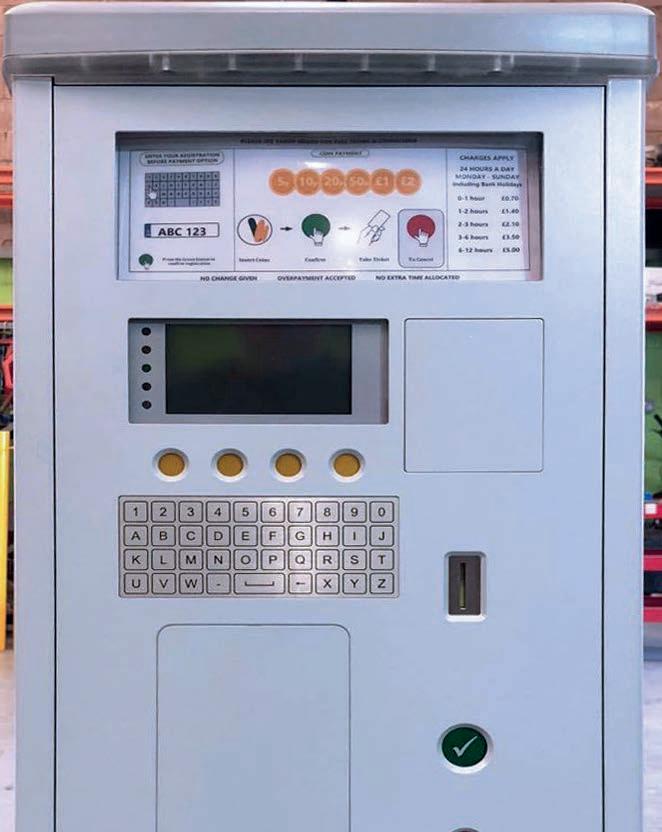
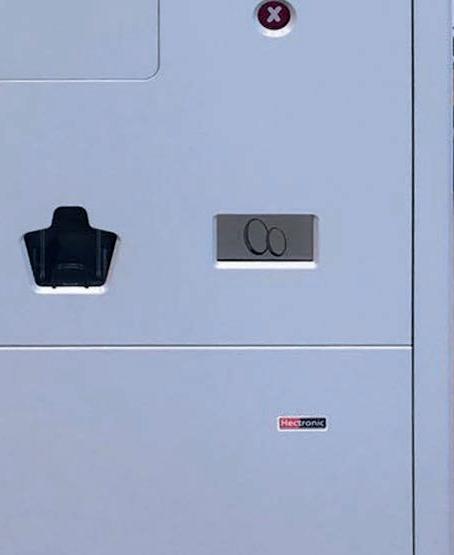














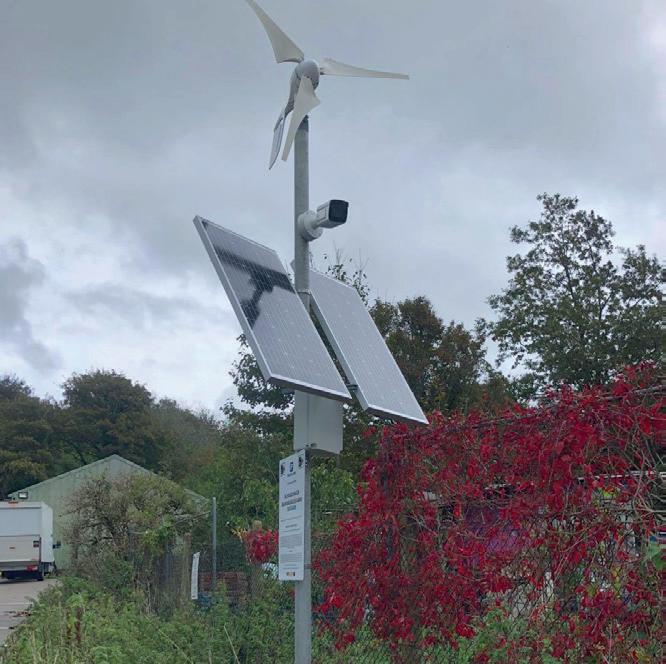









Editorial Managing editor:
Mark Moran
Tel: 020 7091 7871

mark.moran@landor.co.uk
Deputy editor: Deniz Huseyin Tel: 020 7091 7872
deniz.huseyin@landor.co.uk

Editorial director: Peter Stonham
Production and design production@landor.co.uk
Advertising, sponsorship, marketing and exhibition packages

Jason Conboy Tel: 020 7091 7895




jason@landor.co.uk
Subscriptions
Christina Pierre
Tel: 020 7091 7959 subs@landor.co.uk
Accounts
Irina Cocks Tel: 020 7091 7854 irina.cocks@landor.co.uk




Managing Director
Parking
UK

Just months after its launch, the new ‘Parking Code of Practice’ for private land has been suspended after some parking companies sought a judicial review to the government’s plans to cap the parking charges they can impose on drivers who breach terms and conditions. A second legal challenge revolved around the proposal to ban debt recovery fees for parking charge notices issued on private land. The parking companies argued that the legal case for the measures was not strong enough. Faced with challenges, the government has decided to consult more widely on the measures in the hope that its legal case can be strengthened.

The Parking (Code of Practice) Act entered the statute book in March 2019 with the aim of ending self-regulation of the private parking industry. The Act promised a single, ministerially sanctioned code of practice and paved the way for a new independent appeals service and a scrutiny board that would have oversight of the sector. These changes are due be introduced by the end of 2023 at the latest.
The Department for Levelling Up, Housing & Communities (DLUHC) published the new parking code on 7 February. It stated that in England outside of London and in Wales charges were to be reduced from £100 to £70 or £50, depending on the seriousness of the breach. There would be a discount were a driver pays a charge earlier – typically £60 rather than £100. If a driver wanted to appeal the charge, this is frozen while it is investigated by the operator. If the parking firm decides the charge stands, drivers then have the right to take their case to an appeals services.
However, several parking firms claimed reducing charges to £50 would lead to more drivers flouting parking rules because a notice, if settled at a discounted rate within 14 days, could be cheaper than actually paying for parking. ParkingEye and Euro Car Parks are understood to be among the companies seeking the judicial reviews.
The government appears to have accepted that it should set out formally its analysis of the implications of these limits on business in an impact assessment. The Department of Levelling Up, Housing and Communities suspended the new code in June, A government spokesperson said: “We’re determined to end rip-off parking practices, and it’s very disappointing that some in the parking industry are resisting this. We will continue to work with industry and consumer groups to introduce our new Parking Code of Practice as quickly as possible.”
Neither of the parking sector’s two main trade associations were involved in the legal challenges made by operators. Both organisations support the idea of a new code, but stated that want to see their members’ perspectives recognised by government.
The British Parking Association (BPA) welcomed the DLUHC’s decision to review the level of parking charges. Steve Clark, BPA director of operations and business development, said: “We are grateful to some of our members who have exercised their democratic right and made a legal challenge to the decisions made by government. We will be encouraging all of our members, as well as their landowner clients, to respond to the consultation, stressing the need for effective deterrents to stop selfish parking, as well as the introduction of debt recovery fees to ensure that our court system is not swamped.”
The International Parking Community (IPC) said it will await developments. The IPC said: “While ‘temporarily withdrawn’ pending a review of parking charge rates, etc., the rest of the Private Parking Code of Practice can and should be implemented as soon as possible. The ‘connected purposes’ referred to in the title of the Parking (Code of Practice) Act 2019, points to the vital role of the private parking industry as an intermediary between the rights of private landowners and the commercial interests of retailers, investors, and balanced against the rights of motorists. The private parking industry must be able to effectively function as a facilitator to ensure the survival of UK high streets and retail parks through the provision of well managed parking facilities.”
Motoring organisations had welcomed the launch of the code and are deeply unhappy about it being suspended. AA president Edmund King OBE said: “For too long, private parking enforcement has been allowed to degenerate into a Wild West where cowboy operators have been able to ride into a town and set their own rules and punishments. The judicial reviews are a setback but the government must hold firm and restore order among those who like to bully motorists.”
RAC head of roads policy Nicholas Lyes said: “The new private parking code of practice was designed specifically to make things fairer for drivers and end some of the worst practices in the sector. It’s deeply disappointing that the code has been temporarily withdrawn which now almost certainly means yet more delays in it being introduced. Drivers have a right to feel infuriated. The fact that parking companies take issue with the capping of charge notices and debt recovery fees shows precisely why both the code and the cap are needed. For too long, some companies have been allowed to prey mercilessly on drivers who might make an honest mistake and then have to face both over-zealous enforcement and threatening debt recovery letters. The government must stand up to these companies and get the code over the line so we finally have fair and transparent enforcement in the private parking sector.”
Steve Gooding, director of the RAC Foundation, said: “If the private parking industry had been as willing to progress these important reforms as it is to issue tickets we’d probably have the new system up and running by now. As it is motorists face yet another round of consultation and can only hope that doesn’t lead to further delay. Frankly, players in the private parking industry might yet come to regret challenging the plans to reduce the caps on parking charges because the evidence could well lead ministers to conclude they were previously being too generous.
“Can it really be the case that more than eight million drivers set out knowingly to risk a penalty currently of up to £100, or is the vast number of keeper detail requests from private parking companies evidence of a system that is crying out for reform? Surely the ideal would be for no-one to infringe the parking rules, intentionally or otherwise, yet the private parking industry’s determination to fight over the level of charges suggests that this would fundamentally undermine a business model that’s dependent on penalty income. How can that be right?”
The parking code of practice published by the Department for Levelling Up, Housing & Communities on 7 February stated:
• New parking charge levels should mirror the local authority system for publicly accessible car parks, halving many parking charges issued to motorists to £50. The current £100 cap would apply in some circumstances such as abusing Blue Badge bays or if a motorist trespassed on private land.
• Motorists should be offered a 50% discount if they pay within 14 days.
• Parking debt collectors are banned from adding additional excess fees to the level of the parking charge.
• A compulsory 10-minute grace period applies a parking charge is issued.
• A compulsory 5-minute ‘cooling-off period’ applies to allow a motorist to consider the terms and conditions and change their mind about parking.
• Parking firms are not to use aggressive or pseudo-legal language to intimidate motorists into paying charges.
• Parking firms are to clearly display pricing and terms and conditions of parking, contact details and how to appeal a charge.
Under options set out in a new ‘appeals charter’ published alongside the code, motorists are able to appeal a parking charge and see it cancelled entirely if: they have a mitigating reason for overstaying their parking ticket such as their vehicle breaking down; they have made a genuine innocent error, like keying in a digit in their number plate incorrectly; and they have a valid ticket, permit or Blue Badge but failed to display it correctly.
Parking companies who do not follow the code faced being be banned from accessing Driver and Vehicle Licensing Agency (DVLA) data via approved operator schemes run by the UK’s two parking trade associations – the BPA and the IPC.

The Driver and Vehicle Licensing Agency (DVLA) breached data protection laws when it passed on motorists’ personal details to private parking firms, the Information Commissioner’s Office (ICO) has ruled. However, the Department for Transport agency escaped enforcement action after the watchdog concluded the breach was “a technical infringement of the law”.
Parking firms pursuing motorists for unpaid fees use DVLA vehicle keeper data to get hold of their addresses. The ICO said DVLA is permitted to disclose this information where there is “reasonable cause” to do so, such as for the purposes of recovering unpaid parking charges, but it needs to rely on another part of the legislation when doing this..
Information commissioner John Edwards states: “The situation apparently arose because of an unintended change to the interaction between the parking regulations and data protection law, following the 2018 data protection law reforms. The commissioner does not doubt the DVLA’s policy of reasonable cause. He also does not dispute that the DVLA has a power to disclose this information to car park management companies to recover fines.”
Following the Data Protection 2018 coming into force, the DVLA sought advice from the ICO on the correct lawful basis under Article 6(1) of the UK GDPR (General Data Protection Regulation) for sharing the personal data of vehicle keepers with car park management companies to recover fines.
At the time, the DVLA was relying on “legal obligation” as its lawful basis to process this data. Regulation 27(1)(e) of the Road Vehicle (Registration and Licensing) Regulations 2002 allows the DVLA to release keeper information to anyone who can demonstrate reasonable cause for wanting this information. The DVLA thought that Regulation 27(1)(e) provided it with a legal duty to share those details with car park management companies to recover fines. DVLA believed this satisfied the requirement under Article 6(1)(c) of the UK GDPR that the processing is necessary for compliance with a legal obligation.
However, following consideration of the evidence and legal analysis, the commissioner concluded that the DVLA’s correct lawful basis is “public task” and not legal obligation. This is because Regulation 27(1)(e) provides the DVLA with a power, rather than a legal duty, to disclose vehicle keeper information to car park management companies in these circumstances.
In an opinion called The lawful basis for the processing of vehicle keeper data by the Driver and Vehicle Licensing Agency (DVLA), the ICO states: “The commissioner does not doubt that car park management companies have reasonable cause to request keeper information from the DVLA in these circumstances, and that the DVLA is generally required to provide it. However, Regulation 27(1)(e) creates a power rather than a duty as there is a discretion for the DVLA to refuse a request for keeper information in exceptional cases. For example, if the keeper was on a national security protection list. This applies even if the requestor has demonstrated reasonable cause. Public task is the correct legal basis in these circumstances, because Regulation 27(1)(e) creates a task (a power, rather than a legal duty) to be carried out in the public interest (hence the reasonable cause requirement). Disclosing vehicle keeper data is necessary for this task.”
A DVLA spokesperson said “There is no doubt, as confirmed by the ICO that the release of data to private parking firms is lawful. The ICO’s opinion reflects a legal technicality around processing conditions, and also acknowledges it will make no difference to the outcome of data sharing. This has no bearing on the release of data, nor does it affect customers in any way.”
Information commissioner rules driver agency is allowed to disclose driver details to
it relates to parking enforcement in Oxfordshire came into force on 14 July. The orders for the other authorities came into force on 15 July.
English local authorities can now apply to the government to use ANPR cameras to enforce a range of moving traffic offences.
The councils will be able to issue penalty charge notices (PCNs) to those driving into a bus lane, stopping in a yellow box junction, making banned right or left turns, illegal U-turns and driving the wrong way in a oneway street.
A dozen local authorities are set to be the first in England to implement moving traffic enforcement powers after ministers approved their requests and laid an order before Parliament. The Civil Enforcement of Moving Traffic Contraventions Designations and Miscellaneous Amendments Order 2022 lists 12 councils that have applied for powers:
• Bath and North East Somerset
• Bedford
• Buckinghamshire
• Derby
• Durham County Council
• Hampshire
• Kent
• Luton
• Norfolk
• Oxfordshire
• Reading
• Surrey.
“We have examined the historical data and this has led us to use the powers at four trial locations, and enforcement will take place using an approved device. The registered keeper on vehicle will receive a warning notice in the first instance to help educate drivers as to their responsibilities. This approach will be vital to ensuring the transition of powers from the police to the council is not perceived in a negative manner. We hope to be able to assist other councils by adopting the powers early and, in time, broaden our commercial partnerships offering, making full use of our
The powers arise under Part 6 of the Traffic Management Act 2004 and were previously only available in London and then later in Wales.
The new powers are available to English councils on request. Areas can only be designated if
they are already civil enforcement areas for parking contraventions.
Luton Borough Council has applied for powers covering the whole borough, but the others have applied for powers in designated areas. The new order as
The level of fines that can be imposed can range from £20 for lower level PCNs paid promptly up to £105 for late payment of higher level PCNs (such as bus lane contraventions, or parking a vehicle on a cycle path).
Unlike funds raised from speed camera fines, which are transferred to central government, surplus funds from moving traffic enforcement will be kept by the local authority. This surplus must be spent to: recoup costs of enforcement; pay for public transport provision; pay for highway improvement projects; or pay for environmental improvements in the authority’s area.
In May the Department for Transport issued statutory guidance for local authorities on applying for and using the powers that states the aim is to provide “a system that is fair to the motorist, but also effective in enforcing traffic restrictions”.
Explanatory notes accompanying the law change stated the changes may help “improve air quality through reduced traffic congestion”, and “encourage behavioural shift towards sustainable travel choices” by improving bus reliability and making cycling easier.
ensure a green and sustainable future for London. To do this we must continue to make walking and cycling round our city safe and accessible to all Londoners.”
Drivers that infringe on cycle lanes and cycle tracks in the capital can now be fined by Transport for London (TfL) and councils in the same way that moving traffic contraventions are enforced.
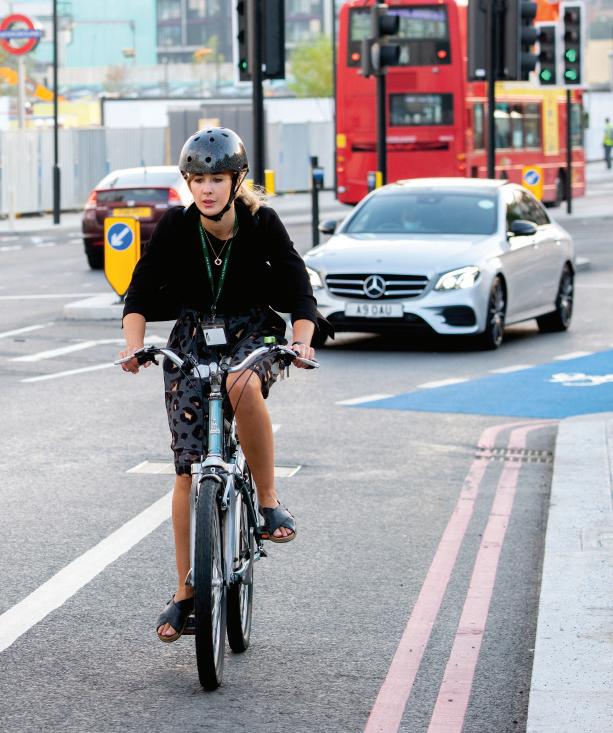
New powers introduced by the government mean that TfL and London boroughs can issue fines to those that drive within, or cross, cycle lane white lines.
Motor vehicles are already prohibited from driving within or crossing cycle lanes that are marked by a solid white line and cycle tracks, but until now this has only been enforced by the police.
Initially, the new powers will be used in 14 locations on TfL’s red route network.
Drivers who infringe on cycle lanes will be sent a £160 penalty charge notice (PCN), in line with any other red route PCNs
The PCN value will be £160 reduced by 50% to £80 if paid within 14 days, as with
any other red route PCN.
Siwan Hayward, TfL’s director of compliance, policing, operations and security, said: “We will start enforcing in key locations in London to deter drivers contravening the road rules. We want to
Will Norman, London’s Walking and Cycling Commissioner, said: “Making London’s streets safer is our top priority. These new enforcement powers will deter motorists from infringing on crucial space specifically designated to keep cyclists safe and will help improve cyclist’s confidence when getting around the capital.”
Rubena Hafizi, Islington’s head of parking service, told Parking Review: “We will most definitely be enforcing these powers to ensure we are doing everything we can to provide a safer network for our cyclists and to encourage more people to use bikes as their main mode of travel. We are hopeful this will promote more active travel by providing a safer environment for cyclists on our roads.”
A Hackney council spokesman told Parking Review that the borough will start enforcing the powers using its CCTV camera network before the end of the year.

TfL and boroughs get powers to fine drivers who infringe on cycle lanes, reports Deniz Huseyin
12 local authorities form moving traffic enforcement vanguard
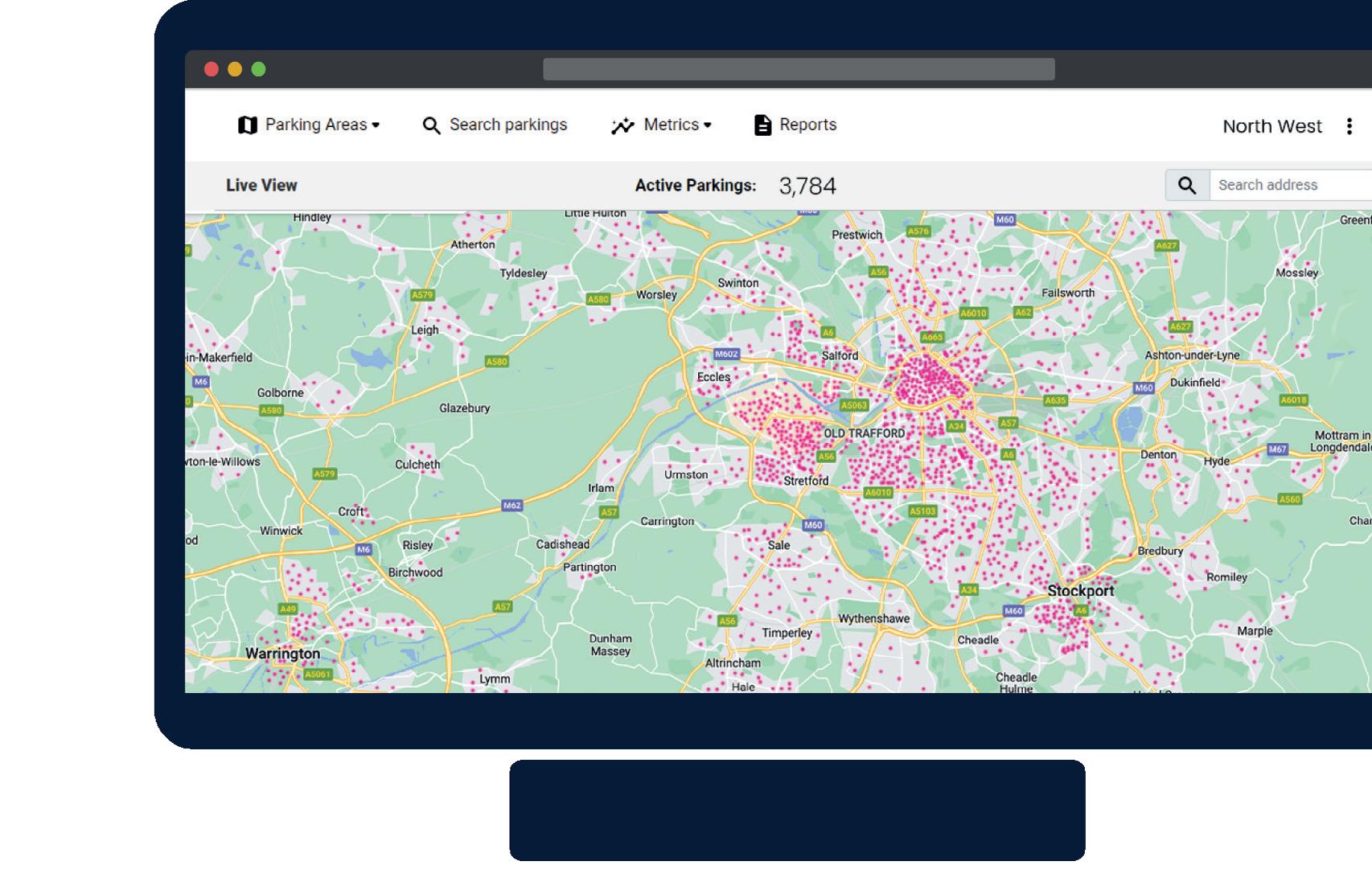
Technology company Port has launched a ‘dark hub’ providing a range of electric vehicles (EVs) that can be hired by couriers making last-mile deliveries in central London.
The EVs are locked and charged in dedicated docking stations at the Q-Park Leicester Square car park, which is being repurposed as a mobility hub.
Port’s dark hub concept enables individual couriers or delivery firms to rent small delivery EVs, including electric bikes, cargo e-bikes, mopeds or scooters at urban car park locations.
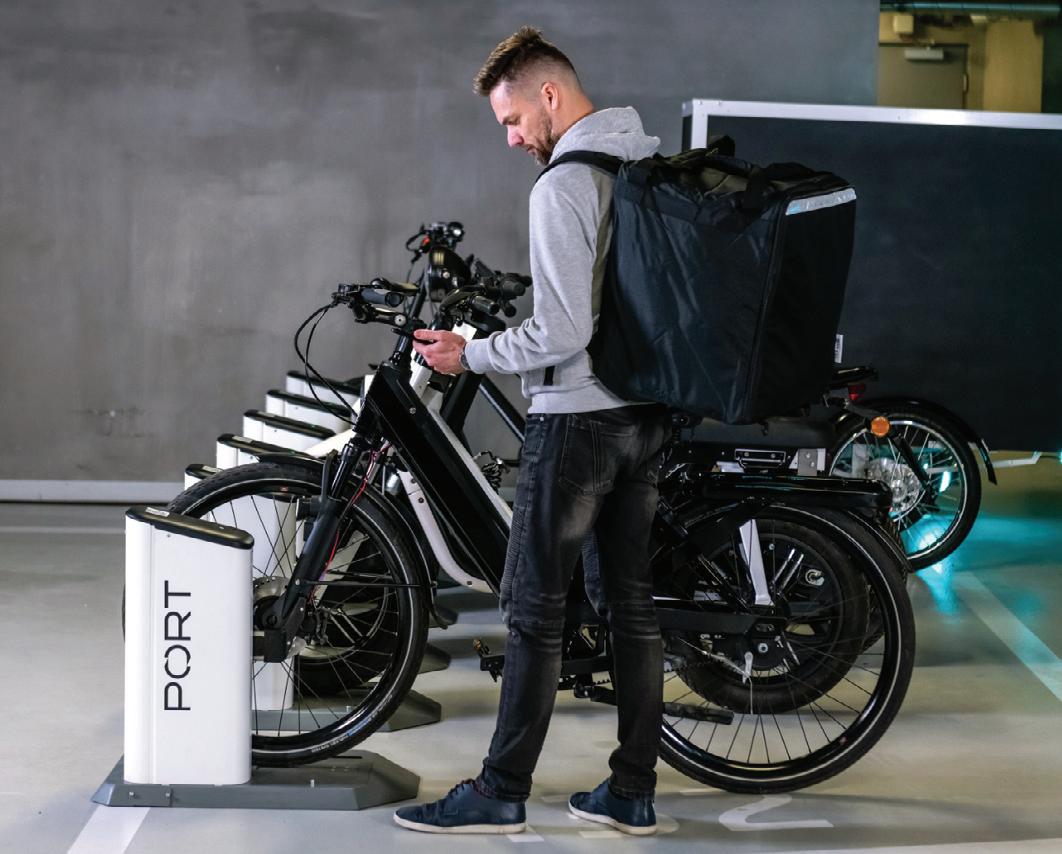
The EVs can be hired on a weekly or monthly subscription through the Port app. The vehicle, parking, charging, maintenance and software are all provided by Port.
Once the courier has picked up the vehicle from the hub, they undertake their deliveries before returning the EV to the hub at the end of their working day. The vehicle is locked, parked and charged overnight and then ready to be rented the next day. The range and battery capabilities of the EVs means they can be used for an entire day of work.
The last-mile delivery sector, which includes parcel, food and grocery couriers, is predicted to grow 10% annually.
Port says that the sector requires tailorable, scalable tech-
based solutions that fulfill growing EV fleet needs. The dark hub launch follows two years of R&D, with Port building every aspect of the platform – including the proprietary hardware and software – from the ground up.
At the heart of the system is a patented universal docking station that can lock and charge any small electric vehicle. This
means Port offers a wide range of EVs to meet the different needs of deliverers of food, parcels and groceries.
Following trials in Madrid and the London launch, the company is now working to expand across Europe, with plans to enter the Barcelona market next.
Kamil Suda, founder of Port, said: “Electrification of the last-
Q-Park is working with EB Charging to roll out charging points across 80 sites in the UK and Ireland. EB Charging will be responsible for the installation of the hardware and management of the charging provision, including a 24/7 customer support service.
Q-Park will invest over £3m in the UK and Ireland on a roll out of initially over 600 electric vehicle charging points across its estate of parking facilities. Installations will start in July 2022, with works including the modernisation of the existing charging infrastructure.
The EB chargers will add to Q-Park’s existing network of city centre charging of over 250 public electric vehicle charging points across its UK and Ireland portfolio.
Disabled Motoring UK is to launch its annual Baywatch survey of Blue Badge provision in car parks this August.
The charity provides the survey data to the parking industry and encourages it to take the parking problems of disabled motorists more seriously and manage their parking provision correctly. The campaign also aims to change public attitudes by bringing to the attention of disabled bay abusers the impact that their actions can have.
Heidi Turner, campaigns and communications director at Disabled Motoring UK (DMUK) said: “Disabled bay abuse is still one of the main concerns expressed to us by our members and the public. Our annual Baywatch campaign is an opportunity to focus the parking

industry on the problems faced by disabled motorists when parking and sends the message that these bays need to be enforced and managed correctly.
“A common problem for many disabled
mile delivery industry is both a great challenge and opportunity. We want to bring Port’s solution to every major city to help the sector reach net zero and fully capitalise on the benefits of small EVs. The platform removes all the courier companies’ electric fleet parking, charging, maintaining, financing and managing burdens. Offered to both independent couriers and delivery firms, Port’s dark hubs mean courier companies can automate currently labour-intensive fleet management tasks and unlock the full potential of EVs.”
Suda said Q-Park offers safe and secure facilities located in the heart of most major centres in the UK, and the Leicester Square car park was a great location for couriers to get an electric vehicle before heading out to pick up deliveries.
Q-Park is working to develop parking facilities into mobility hubs that provide access for shared mobility schemes, electric vehicle charging, last-mile delivery and retail space all within their safe and secure parking facilities. John Denton, head of sales and marketing at Q-Park UK said: “We are delighted that Port have decided to work with us to operate from our Leicester Square car park. We believe that our safe and secure facilities offer an ideal location for Port vehicles to be located and easily accessed by couriers. We are delighted to once again demonstrate why we are at the forefront of sustainable urban mobility.”
motorists is not being able to park at their desired destination. The major complaint is that the disabled bays are all occupied with cars not displaying a Blue Badge.
DMUK’s Baywatch campaign researches opinions about disabled parking abuse.
“Last year we received over 850 responses, breaking all records, which goes to show that many of our members are still experiencing massive problems when it comes to finding suitable and properly enforced disabled parking,” says Turner.
The survey will ask disabled drivers to think back over the last 12 months to consider their general parking experience and ask them to answer some questions about this experience at supermarkets and at other car parks. “We will use this data to tackle the supermarkets and other parking providers over their disabled parking policies,” says Turner. www.disabledmotoring.org
Q-Park and Port to hire out electric vehicles for last-mile deliveriesA Port dock
Transport Committee investigates future of autonomous vehicles
Once the stuff of driving dreams, self-driving technology is getting closer. In April 2022, proposed revisions to the Highway Code were laid before Parliament to provide for self-driving cars.
The House of Commons Transport Committee has thus announced an investigation into the development and deployment of self-driving vehicles, also known as connected and autonomous vehicles, on the UK’s roads.
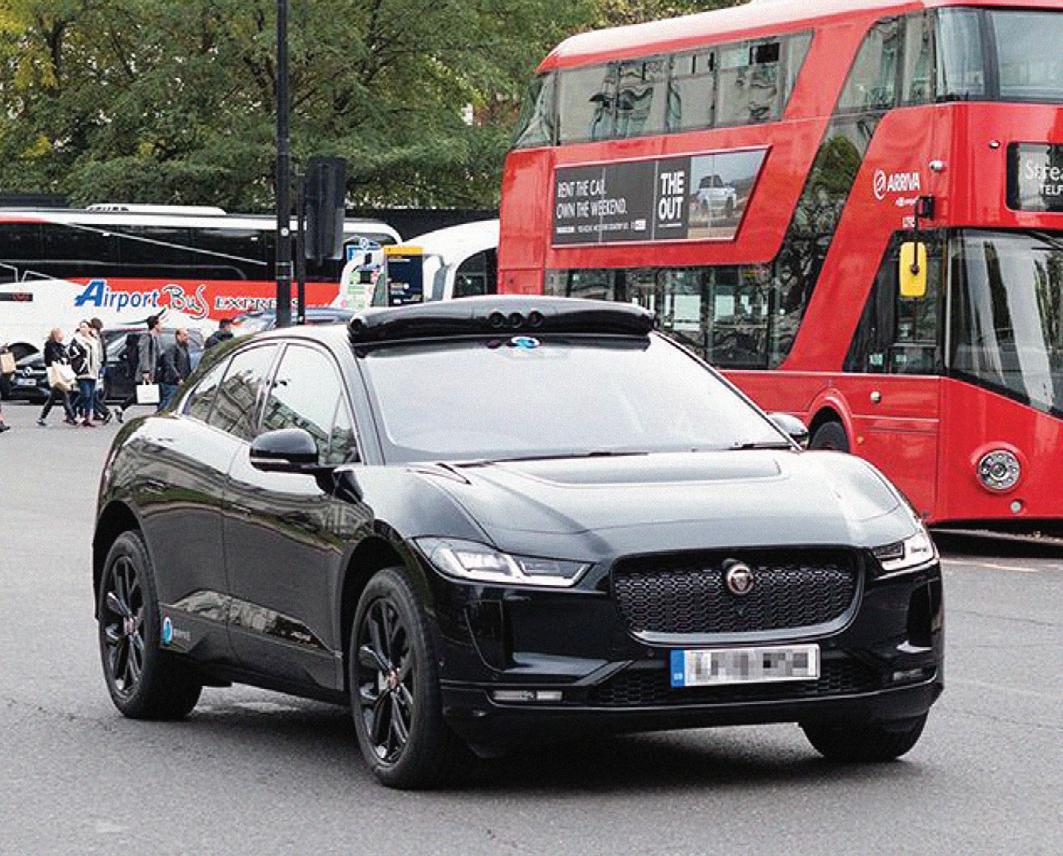
The inquiry will consider the progress of research and work in the UK and abroad and what needs to happen to prepare for their arrival. This includes regulation, perceptions of safety, the role of government, implications for infrastructure and for existing car use.
The UK government has said that it is “continuing to develop a full legal framework for selfdriving vehicles”. A full regula-
tory framework for widespread deployment of automated lane keeping system technology is expected to be in place by 2025.

The first approved technology is likely to be for vehicles travelling at slow speeds on motorways, such as in congested traffic. Until now, self-driving vehicles have been deployed on UK roads as part of pilots such as the MOVE and Wayve trials.
The Law Commission of England and Wales is seeking views on regulating remote driving on public roads, building on earlier recommendations from the Law Commission and Scottish Law Commission for reform to enable the safe and responsible introduction of automated vehicles.
In setting out its terms of reference, the committee said it is
interested in receiving written evidence that address issues such as:

• likely uses, including private cars, public transport and commercial vehicles, and levels of automation
• progress of research and trials in the UK and abroad
• potential implications for infrastructure, both physical and digital
• the regulatory framework, including legal status, approval and authorisation processes and insurance
• safety and perceptions of safety, including the relationship with other road users such as pedestrians, cyclists and conventionally driven vehicles
• the role of government and other responsible bodies, such as National Highways and local authorities
• potential effects on patterns of car ownership, vehicle taxation and decarbonisation in the car market.
The closing date for written evidence is Monday 22 August 2022.
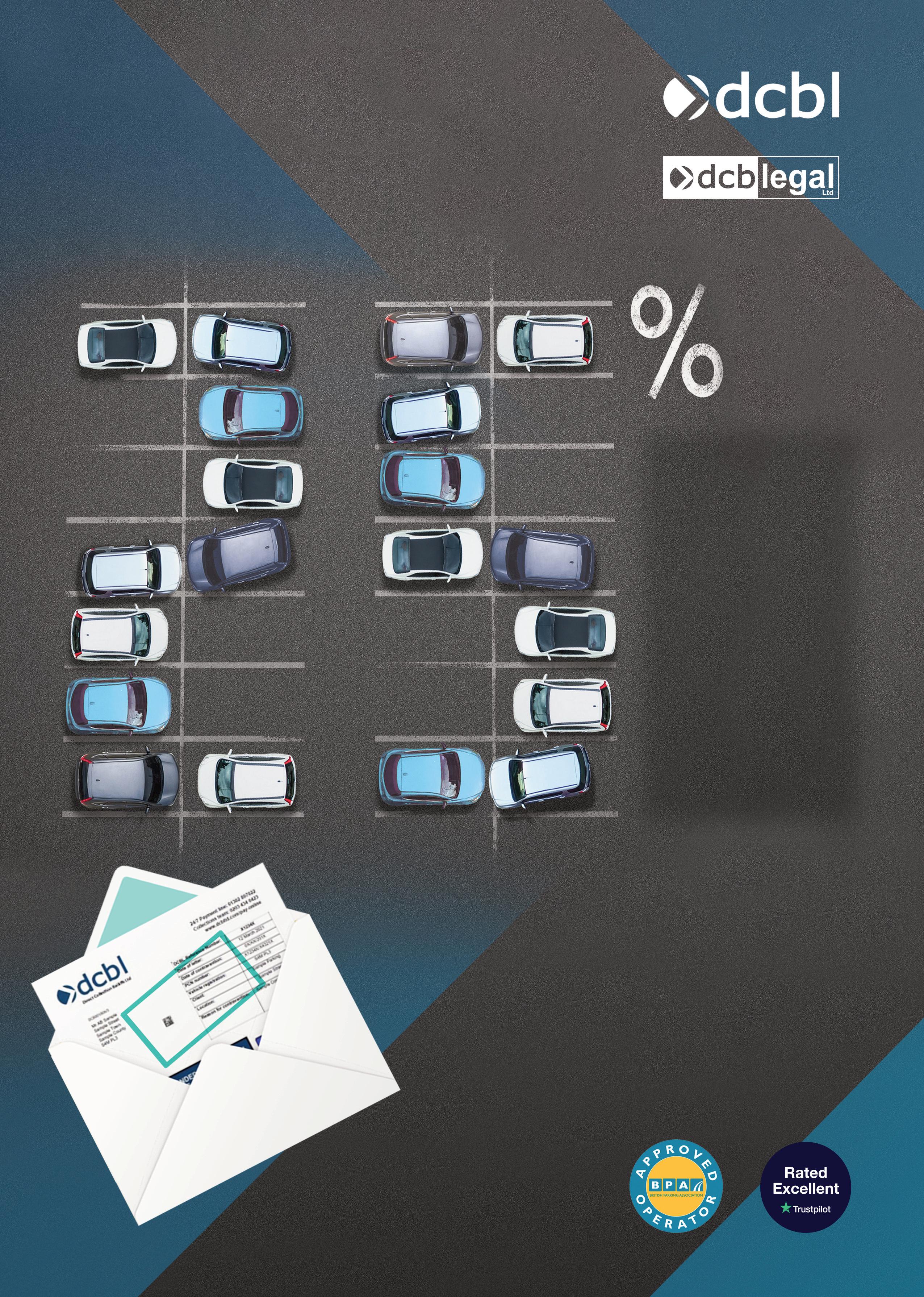














bystander awareness and education to help prevent harassment of women.
The lack of safe, segregated road space is discouraging women from hiring e-scooters, according to new research.
Some 79% of female respondents said that not feeling safe due to infrastructure was a barrier to riding. It found that, similar to cycling, only 30% of e-scooter riders in the UK are women.

In general women also want to gain a better understanding of the law around e-scooters, and need access to safe, well-lit parking spots, said the study by urban mobility firm Voi, JFG Communications and Women in Transport.
Although e-scooters are widely available for sale to private owners, they are illegal to ride on either roads or pavements, since they do not conform to our vehicle regulations.
However, exemptions to these regulations by the government were introduced to allow e-scooter hire schemes to be trialled in many UK cities, with
pilots due to end this autumn.
Research included both a questionnaire of nearly 500 women and five focus groups.
Key findings and recommendations include:
• 79% of respondents said that not feeling safe due to infrastructure was a barrier to riding.
• Local and national governments should prioritise infrastructure development and reallocation of road space in our cities. This should be at the top of their transport, environmental and public health agendas.
• 83% of survey respondents agreed that drivers’ attitudes
towards e-scooter riders was a barrier to using shared e-scooters.
• Local authorities should provide clear communications about the status of shared e-scooters in their regions.
• 90% of overall survey respondents agreed that they were confident riding a scooter in the day-time, but only 64% at night-time.
• Local authorities and e-scooter operators should collaborate to ensure local environments support night-time safety for women, ensuring public spaces are sufficiently lit, and providing
• 83% of respondents think docking locations can be a barrier to riding if not located in safe, useful areas.
• Councils and e-scooter operators should collaborate to ensure women’s transport needs inform the development of e-scooter regulation in specific areas.
• While 99% of regular riders understand the difference between private and shared scooters, 59% of non-riders said understanding of laws surrounding e-scooters was a barrier to riding shared e-scooters.
• Government(s) should provide clarity over laws around both shared and private e-scooters.
Following these findings, Voi are taking steps to reduce this gender gap, such as piloting night-time safety events.
They are also working towards creating a new Gender Safe Parking Standard, which assesses parking locations based on women’s safety, to ensure Voi’s Parking Zones meet the requirements.
A motorist has been ordered to pay more than £1,800 after passing too close to a cyclist on a Welsh road. The incident happened on the B4280 Pant Hirwaun outside Heoly-Cyw, near Bridgend in September 2021. The cyclist recorded the close pass on a GoPro camera and reported the incident to roads policing teams.
Holidaymakers using airport meet & greet firms risk having cars damaged, stolen and driven without permission, the police have warned. Cheshire Police said more than 55 incidents had been reported since January at car parks in Lode Hill and Moss Lane, in Styal.
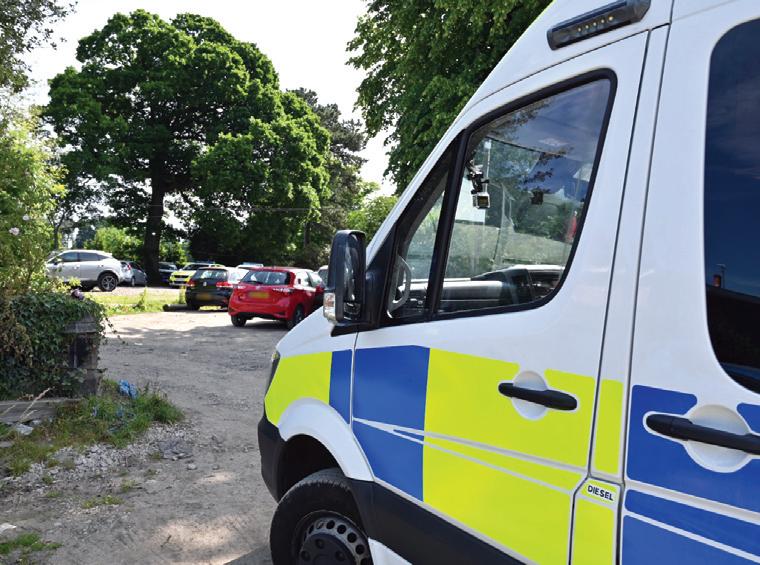
Motorists using meet & greet companies operating near Manchester Airport have found their cars left in muddy fields.
One owner reported that their car had been driven more than 3,000 miles, another had their car bonnet stolen. In April, about 150 people said they returned from holiday and their car keys were missing.
Inspector Andrew Baker from Cheshire Police
said many of the owners had made their bookings through online comparison sites and believed they were secure. “In reality, many of these car parks are simply muddy fields on land bordering the runway and have no affiliation to the airport whatsoever,” he said.
While many of the businesses were not operating illegally, the police some of the activity on their sites was illegal and some of their services were questionable. A search of one of the Styal sites led to cannabis and drug paraphernalia being found, and two men were arrested on suspicion of supplying class B drugs.
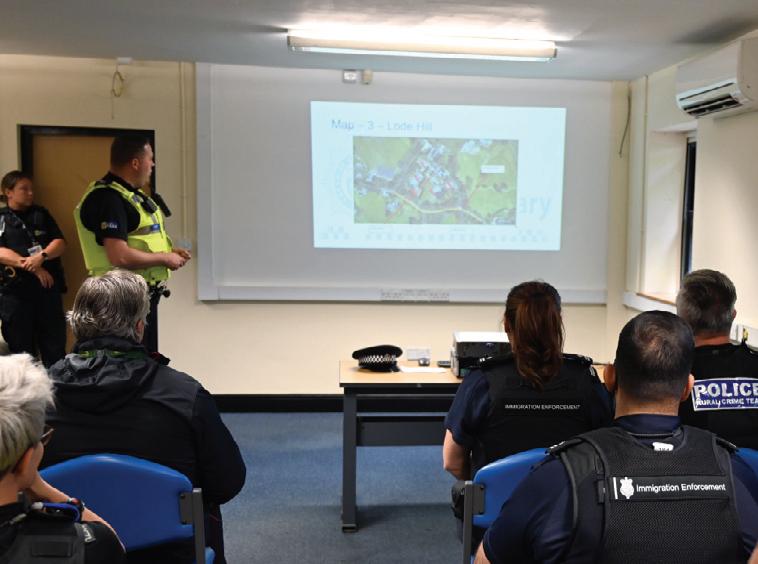
An airport spokeswoman urged passengers to do research before booking a parking service. “In addition to our own official parking products, there are a number of reliable and reputable third-party providers located near the airport.”
Wayne Humphreys, 77, was fined and given four penalty points for failing to leave enough space when driving in his Audi Q8.
Humphreys had refused to attend the course or pay a fixed penalty notice. Humphreys then failed to comply with a fixed penalty notice, resulting in the prosecution on 8 June, when he was fined £1,152 and ordered to pay £620 costs and a £115 victim surcharge.
He was then prosecuted at Cardiff Magistrates’ Court for driving without due care and attention and ordered to pay £1,887 in a fine and costs, and received four points on his licence.

Holidaymaker’s car was driven 3,000 miles in off-airport parking scamAnnie Marstrand looks at how to make micromobility inclusive 90% of respondents are confident using e-scooters in daylight A police briefing













All councils in Greater Manchester have endorsed a scheme which proposes scrapping plans to charge the drivers of polluting vehicles. Instead, it is proposed to offer financial incentives for motorists to switch to electric vehicles. Greater Manchester council leaders have agreed to a non-charging category B Clean Air Zone.
The 10 Greater Manchester local authorities have been directed by government to bring NO2 air pollution within legal limits as soon as possible and by 2026 at the latest. The previous Greater Manchester Clean Air Plan (GM CAP) would have seen drivers of polluting vehicles paying charges ranging from £7.50 to £60 to enter one of the 10 local authorities.
The Clean Air Zone (CAZ) was due to go live on 30 May, but this was postponed by Mayor of Greater Manchester, Andy Burnham in February and the deadline to bring air pollution below legal limits was pushed back by two years to 2026. Burnham requested more time to allow local authorities to review plans after evidence suggested the city was unlikely to meet legal emissions limits by the original date of 2024. He cited evidence provided by Greater Manchester authorities that suggested the impact of issues such as COVID-19 on supply chains and the price of secondhand vehicles would make it harder for people to upgrade to cleaner vehicles.

City-region leaders then released new proposals for the Greater Manchester CAZ that it argued the scheme should be non-charging, showing how £120m of government funding could be used to help owners adapt or retrofit their vehicles. On 1 June, environment secretary George Eustice wrote to Andy Burnham and Cllr Andrew Western, Greater Manchester Combined Authority (GMCA) portfolio lead for clean air, suggesting Greater Manchester consider a smaller charging Clean Air Zone covering Manchester city centre.
However, all of Greater Manchester’s political leaders have stated that they feel clean air compliance should be achieved through an investment-led, non-charging approach.
The Case for a new Greater Manchester Clean Air Plan: Greater Manchester’s Clean Air Plan to tackle Nitrogen Dioxide Exceedances at the Roadside sets out evidence supporting an investment-led, non-charging Clean Air Plan as the solution to address roadside nitrogen dioxide (NO2) problems.
Unlike the previous charging CAZ plan defined by government guidance, the leaders claim a non-charging GM CAP recognises the cost-of-living crisis through avoiding setting of tariffs. They also argue that it would address the impacts of the pandemic
The approach set out in the Case for a new Greater Manchester Clean Air Plan includes:
• Evidence that economic conditions have deteriorated significantly since the previous Clean Air Plan was agreed in summer 2021, with businesses in Greater Manchester now dealing with the cost-of-living crisis, soaring inflation and high vehicle fuel costs.
• New analysis which shows how an investment-led approach could see financial support targeted towards upgrading vehicles which frequently travel through locations where modelling shows exceedances of legal NO2 limits might otherwise continue.
• A commitment to review local policy changes, such as goods vehicle access controls, alongside regulatory measures such as vehicle licensing standards to accelerate fleet upgrades.
• A proposal to work with government to agree the targeted use of the CAP ANPR cameras to support identification of vehicles that could be upgraded, and also for potential law enforcement activity related to the detection of crime.
particularly on Manchester city centre, where Greater Manchester needs to support ongoing recovery due to changes in economic activity and the impact of wider global economic instability on supply chains.
Burnham said: “The Case for a New Greater Manchester Clean Air Plan outlines how Greater Manchester would meet air quality legal limits in a way which is fair to local people and businesses and does not create the risk of financial hardship. Our city is still recovering from the pandemic and we don’t want the government to leveldown our city-centre with their proposals to charge businesses from across Greater Manchester who have to travel through or work within the proposed charging area.
“Even a small charging Clean Air Zone would result in a considerable financial burden for the many businesses moving products and people through Manchester city centre, providing a significant setback in economic recovery from the impact of the pandemic, and during a cost-of-living crisis. The government wants us to charge Greater Manchester businesses at a time when they can least afford it.”
The submission addresses concerns that the price of new and used commercial vehicles is rising, making upgrade less affordable, with anecdotal evidence that the trade-in value of Euro 5 and older Hackney cabs is falling, as more cities bring in tighter licensing standards and/or Clean Air Zones.
The report states some sectors potentially

in scope for the Clean Air Plan have still not recovered from the impacts of the pandemic, including the coach sector, with lockdown restrictions meaning that many were forced to stop operating for long periods. It is argued that previous GM CAP became unworkable due to changes in the global vehicle supply chain linked to the pandemic and the emerging cost-of-living crisis. It would have imposed daily charges for non-compliant vehicles that owners might not have been able to upgrade to cleaner vehicles.
Cllr Western said: “The health impact of dirty air is a primary concern for Greater Manchester, and we remain determined to tackle it in a way which does not create financial hardship for local people. We have been listening to the views of business leaders and, given the poor economic outlook for the UK as a whole and Greater Manchester – coupled with increasing evidence of the harm poor air quality causes – this is a delicate balance. Based on the evidence, including the impact that a charging Clean Air Zone would have on their ability to make a living, and the risk to jobs and livelihoods, we have had the opportunity to fundamentally change the nature of the Clean Air Zone scheme which we now feel is fit for purpose and fair to the people of our cityregion. We will now move into a period of more intensive engagement with business and the community to bring together the detailed policy of the new Clean Air Plan.”
Mayor and city leaders lay out the case for a non-charging CAZ for Greater Manchester

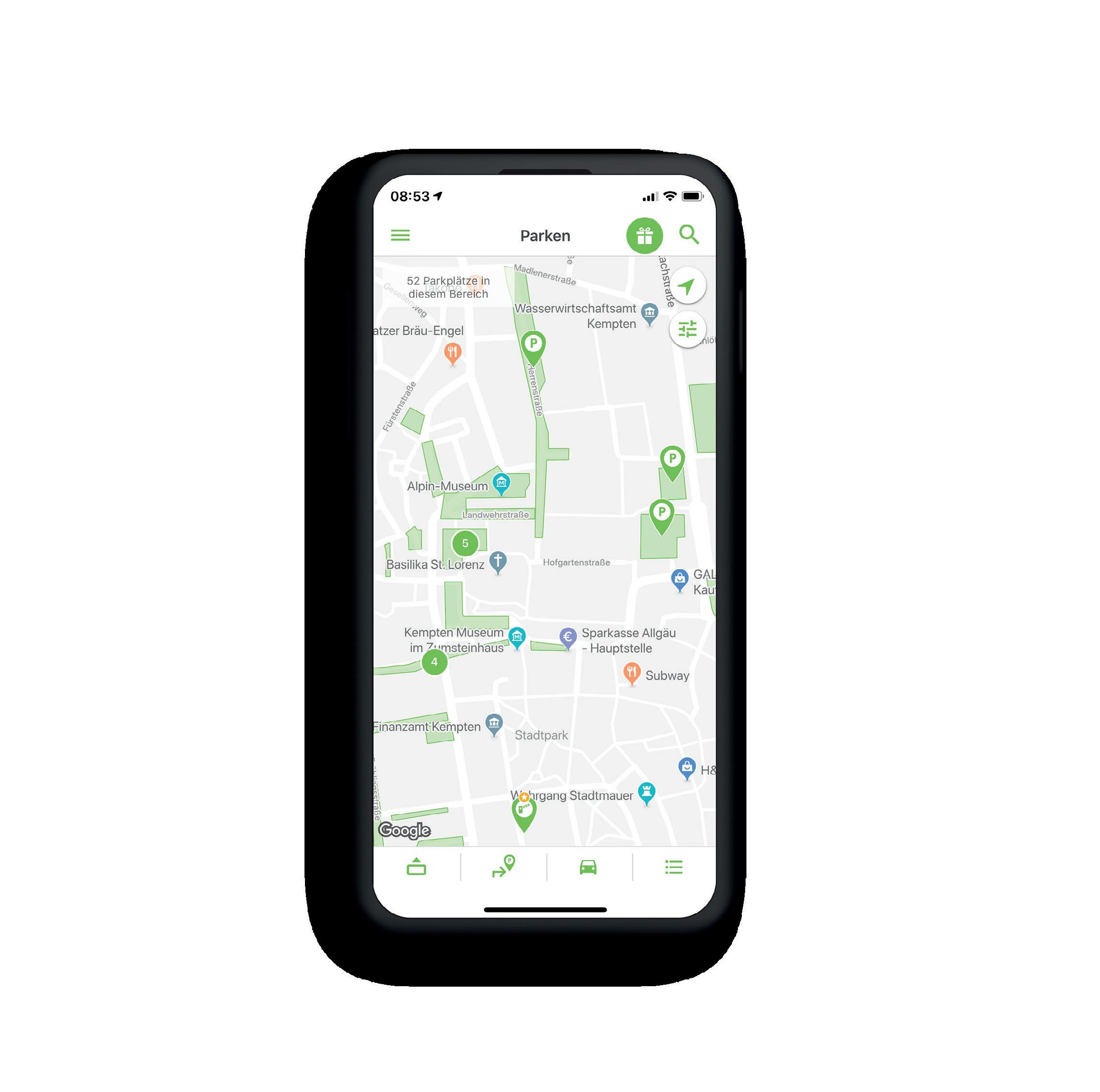


London’s low traffic neighbourhoods (LTNs) benefit local streets, but the next generation of schemes could be made more effective and less controversial with good design, community engagement, and tailored support for those who are most impacted, says a report from think-tank Centre for London.
Street Shift: The Future of Low Traffic Neighbourhoods reviewed the roll-out of LTNs by London local authorities over recent years. The research was funded by the Foundation for Integrated Transport, and sponsored by Enterprise Holdings, the London Borough of Enfield and London Borough of Lewisham.
Centre for London found that LTNs can benefit local streets by reducing car traffic, increasing walking and cycling, and making roads safer for all users. But the report argues that LTNs alone cannot address reliance on the private car because they do little to reduce the traffic on main roads and, in some cases, there has been an increase in traffic outside of the LTNs.
The think-tank sees LTNs as part of the solution to reducing private car use in the capital, but argues they should be introduced alongside complementary measures including promoting cycle training, introducing new public transport options, and establishing a denser network
of bike and scooter hire, and car clubs.
Centre for London calls on government to give new powers to the Mayor of London and the boroughs to achieve behavioural changes that reduce the use of private cars. With these powers, funds can be raised for the delivery of complementary changes such as protected cycle lanes, financial incentives such as mobility credits, and investment to improve public transport.
The report makes recommendations to improve the design, experience and outcomes of LTNs. Reviewing schemes that were introduced during and after the pandemic, the think-tank found that councils and Transport for London (TfL) need to take action to minimise traffic displacement, including across borough boundaries.
Reviewing monitoring data from nine schemes, Centre for London found there were big reductions in car traffic inside
the low traffic neighbourhoods (ranging from 76% reduction to 25% reduction) but the picture is more mixed for car traffic on boundary roads (ranging from 11% decrease to 21% increase).
The report highlights these schemes were implemented as emergency measures and could not follow usual standards in terms of consultation and design. It recommends that traffic modelling should be done before implementation of the next generation of schemes and must include monitoring changes outside the LTNs early on. Based on the evidence that emerges, incremental improvements could be made to schemes, including the location of modal filters such as bollards, cameras and planters.
LTNs significantly increase cycling levels but more could be done to encourage take-up. Reviewing monitoring data from seven schemes, the report found that there were substantial increases in cycling within the
low traffic neighbourhoods (ranging from 31% increase to 172% increase). The report argues that more could be done to encourage walking and cycling, from reallocating road space and redesigning junctions, to widening pavements and promoting cycle training.
More also needs to be done to make sure road users are aware of changes to road access, including emergency vehicles, delivery vehicles and Blue Badge holders. The report calls for the introduction of a national open database of planned changes to road access rules and early work to ensure that new measures are mapped onto online source data for satellite navigation systems. Where necessary, the report recommends that local authorities switch from physical to cameraenforced filters that allow emergency services access.
The report recommends that the government should make funding available to local authorities and TfL so that they can engage residents meaningfully over LTNs and support those who are most impacted by their introduction.
London should develop a denser network of bike and scooter hire, car clubs, and new public transport options. The Mayor of London should also consider changing current road pricing schemes like the Congestion Charge and ULEZ to distance-based road user charging, accompanied by new charges and controls on workplace and residential parking.
More than two-thirds (70%) of streets in Hackney now have Low Traffic Neighbourhoods (LTNs), compared with just 4% of streets in Bexley, reveals the new Healthy Streets Scorecard published today.
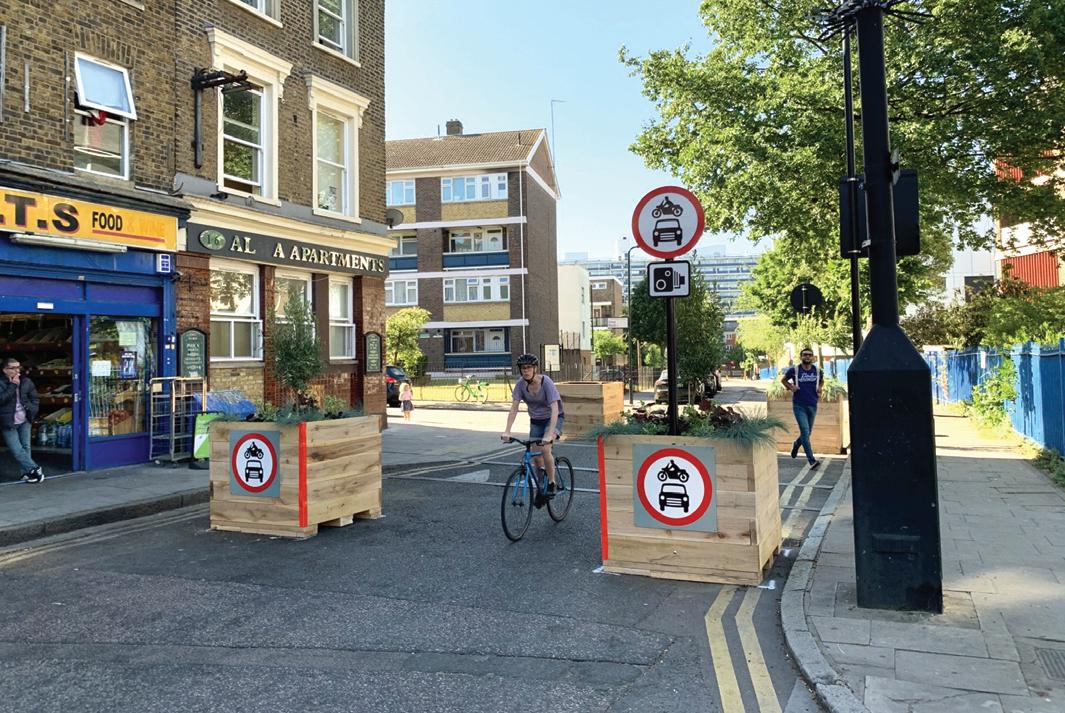
The Scorecard, published by a coalition of organisations, ranks London boroughs on how healthy their streets are according to nine indicators including the provision of LTNs, bus priority measures, School Streets, Controlled Parking Zones and 20mph limits. There are no School Streets in Bexley, Hammersmith & Fulham, and Sutton compared with 49% of schools in Islington. Furthermore, almost 60% of London boroughs have 20mph speed limits on 100
borough managed roads. By contrast, just 5% of Barnet’s roads have a 20mph limit.
The data reveals a wide variation in the proportion of bus routes prioritised. In Hackney, Islington and Lambeth, 40-50% of routes are prioritised whereas just 1% are prioritised in Bexley. Research also showed that the total number of cars registered in London fell by 1.5%, or 38,923 cars, despite London’s population increasing by 1.22%. There were particularly significant falls in car ownership in Newham (4%), Southwark (3.7%), Camden (3.2%), and Waltham Forest (2.9%).
Road danger is shown to be not reducing fast enough, as road casualties in 2021 among cyclists and those using “other vehicles” (such as e-scooters) were above pre-pandemic levels. There were 3,581 fatal and serious reported road casualties in
2021, an increase of 511 from 2020.
A Healthy Scorecard coalition spokesperson said: “These results raise serious concerns about worsening health inequities as the gap widens between highest and lowest scoring boroughs. In spite of difficulties, some boroughs have still managed to make progress. With the top scorers continuing to demonstrate it’s possible to deliver Healthy Streets and transport decarbonisation amid a funding crisis, and in an election year – the question remains, why are others not delivering?”
The members of the Healthy Streets Scorecard Coalition are: CPRE London; London Living Streets; London Cycling Campaign; Sustrans; Possible; RoadPeace; Wheels for Wellbeing; Future Transport London.
www.healthystreetsscorecard.london/results
Centre for London sets out ideas for local road
to support buses and active travel vary across capital, reports Deniz HuseyinAn LTN in Hackney
New CEO will run 1,300-city operation from Vancouver
Jonny Combe is stepping into his new role as PayByPhone’s global chief executive. Thirtysix-year-old Combe, who was already part of the cashless parking provider’s senior leadership team, will take over from chief executive Andy Gruber, who has been in the role for four years.

Gruber will exit the role effective 1 August, to take up a senior management position within PayByPhone’s parent company Volkswagen Financial Services AG. Gruber will also sit on the PayByPhone supervisory board, to which Combe will report, headed by Stefan Imme, chief digital officer, Volkswagen Financial Services AG.
Imme said: “The journey of growth and development that Andy has led over his four years has been incredible. On behalf of Volkswagen Financial Services AG, I want to thank Andy for his hard work and dedication.
“As we enter the next stage of growth for the business, we are confident it is in great hands with Jonny. His track record of success sets him up well to lead the dynamic and fast-paced PayByPhone Group, ensuring exceptional results.”
Earlier this year PayByPhone unveiled a new internationalleadership structure. The new
Craig Taylor has joined financial technology company Planet Payment as solutions manager –parking. Taylor joins Planet after spending over 18 years working at Cornwall Council, where he was strategic parking manager.

He started his parking career as a parking attendant at TFM Contract Services in 1994, and has recently been elected to one of the Parking Technology seats on the British Parking Association Council of Representatives.
global structure focusses on supporting three key customer groups: clients such as cities, local authorities and parking operators; corporate clients, including fleets and businesses; and consumers, the drivers who use PayByPhone’s services.
The new structure saw Combe promoted to lead the global corporate division as chief executive corporate. Before taking responsibility for the corporate business, Combe was chief executive of the UK market, a position he held for four years.
Combe said: “I am delighted to be taking on this role, continuing the exemplary global leadership that Andy has demonstrated, and working alongside
our exceptional leadership team.
“As we evolve and grow, I want to drive our ethos of simplifying our clients’ and customers’ journeys and encourage our teams across the globe to continue to embrace our winning mindset. The reason is simple. We are in a unique position; PayByPhone is the only player in our industry to have an app that can be used globally, in nearly 1,300 cities.”
Combe will relocate from the UK to Vancouver, Canada. He will continue to lead the corporate division until a replacement is appointed.
Before joining PayByPhone, Combe held several management roles at BMW Group, looking
after its environment, real estate, mobility, and innovation team in EMEA. He spearheaded BMW’s digital and innovation programmes in the UK and pioneered the birth of the awardwinning BMW Innovation Lab.
The new global approach sees Roamy Valera, a 30-year veteran in the industry, serving as chief client officer and Ryan St Hilaire, PayByPhone’s vice president, product, being responsible for the global consumer division.
Combe’s promotion in April led to Anthony Cashel stepping up to lead the UK operation.
During Andy Gruber’s tenure at the company, PayByPhone more than doubled the number of monthly active users of the its app and expanded its coverage from five to 11 countries around the globe.
Gruber said: “Jonny is in a unique position to lead the business through our next phase of growth, thanks to the senior leadership positions he’s held since he joined PayByPhone in 2018. Our app is available in nearly 1,300 cities, compared to just over 400 four years ago, and that trajectory is set to continue.
“Jonny fully understands not only our products and services, but also the challenges our clients and customers face. I have full confidence and trust in Jonny as I hand the reins to him. This is an exciting time for PayByPhone.”
APCOA Parking has acquired UK-based Gemini Parking Solutions in a move designed further strengthen its Park and Control division.
Gemini was launched in 2012 by entrepreneur Ryan Jackson, who grew the business from sole-trading to a professional office of 28 core staff and a portfolio of 110 sites providing an estimated 17,000 spaces nationwide.

Gemini delivers services across NHS sites such as St Barts NHS Trust as well as leisure and entertainment clients such as the Queen Elizabeth Olympic Park, Hilton Hotels, Burger King and Greene King.
Gemini was named Parking Provider of the Year in the British Parking Awards 2022.
The price paid by APCOA for Gemini has not been disclosed.
APCOA will incorporate Gemini’s 100 locations into its portfolio of 1,400 car parks across the UK via its Park and Control brand, which focusses on managing parking in city and town centre locations on private land.
It is expected that rebranding of Gemini sites to APCOA will take around six months.
While Ryan Jackson is not staying, the rest of the management team and employees will be moving to APCOA.
Kim Challis, APCOA’s regional managing director UK&I, said: “Gemini Parking Solutions is an award-winning
business in this sector and will be a great fit with APCOA –we look forward to welcoming our new colleagues.
“APCOA and Gemini have both actively supported improvements targeted by the new parking code and we will continue to strengthen robust policies and procedures to ensure all car park users are treated fairly, with respect and consideration.
“We’re also excited to develop more innovative solutions in this area and to maximise opportunities in agreement with our clients, through the provision of our Urban Hub strategy where we will deliver a range of community-focussed products and services to create more sustainable urban life.”
Parking technology company Metric has made key appointments to its management team, which is led by managing director Chris Wortley
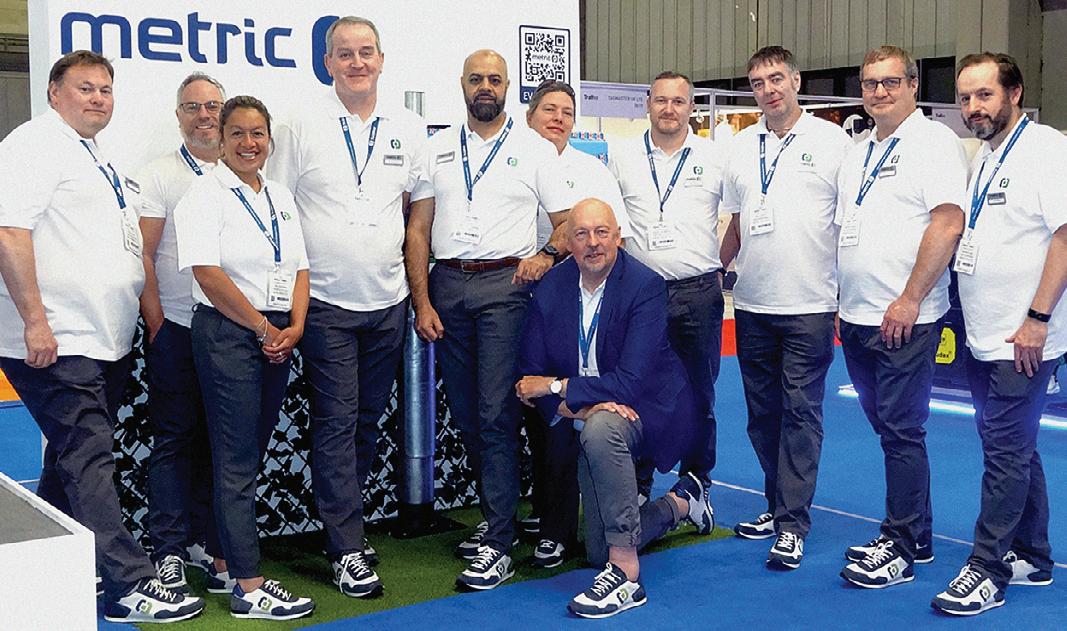
Metric has hired Lisa Woodman as its new solutions sales manager for UK and EMEA. Woodman has a background in energy saving solutions, and worked in the field of electric vehicles and chargers some 10 years ago.
Metric has also announced a number of internal appointments. Nick Heal has been named finance director. He joined Metric in 2020 as head of finance. His new role allows him to focus on higher level strategic areas.

Kirsty Kaye, who started at Metric less than a year ago, has been named fulfilment manager. She will oversee all aspects of an order, tracking machines through the production process and onto delivery and dispatch.
Simon Killane has been
appointed as product delivery manager. He has worked at Metric for five years in various roles including design engineering, production engineering and project management. His new position will focus on delivering product solutions to customers.
Joe McManus has been named head of sales, UK and Ireland. He started with Metric in 2020 as part of the sales team.
Paul Turley, who has been appointed to the role of training manager, has worked for Metric as a technical support engineer since 2002. His new role will see
Cameron Clayton, chief executive of EasyPark Group, said: “We are constantly working to increase the usefulness of our services. In addition to developing more features, the range of payment methods is an important part of this. Our aim is to make all aspects of parking and mobility easier for our users, which makes UnionPay, one of the world’s most widely used payment card networks, an obvious partner.”
him create, organise and deliver training courses for Metric staff and customers, ensuring maintenance technicians and engineers.
Steve Wybrow has been named implementation manager. He joined Metric in 2013 as a senior technical consultant working on pay-on-foot systems.

Matt Hammond has been made technical quality assurance manager. He has been working for Metric since 2006 and is now responsible for hardware and software quality, ensuring updates and changes work.
Q-Park said an expansion the provision of electric vehicle charging and cycle parking has complemented energy management systems to make its European operations more sustainable.
The company has a portfolio of 3,300 parking facilities providing more than 640,000 spaces.
Q-Park’s annual corporate social responsibility (CSR) report covers the company’s social engagement, environmental impact and its contribution to helping achieve UN sustainable development goals (SDGs) relevant to its business.
In 2021 the company achieved:
• An average carbon footprint per parking space of 93 kgCO2, a 51% reduction since it started measuring in 2010 (190 kgCO2)
• 2,114 EV charging points (2020: 1,190), an increase of 77.6%
• 385 sites offering online prebooking services
• 209 sites offering access to major public transport hubs
• 119 sites offering bicycle parking and micromobility.
Cashless parking provider
EasyPark has signed a global partnership with the UnionPay International card network.

UnionPay cardholders can now manage their parking and electric car charging by binding their UnionPay card directly in the EasyPark app.
The partnership is valid in the majority of the European countries and regions where EasyPark operates. There are also plans to extend the cooperation between the card network and EasyPark Group to Australia, the USA and the UK, where it owns the RingGo brand.
Han Wang, deputy manager of UnionPay International European branch, said: “By establishing this strategic partnership with EasyPark, UnionPay cardholders can access the most advanced car parking and charging service in many European countries and regions, which significantly improves acceptance in this key transportation sector.”
The EasyPark app allows drivers to manage their parking, charge their electric vehicle and make use of smart features in the app such as Find, an AI solution claimed to reduce the time to find a parking space by up to 50%.
We currently supply and have vacancies around the UK for Permanent and Temporary positions:
• Civil Enforcement Officers
• Environmental Enforcement Officers
• Parking Back Office (Appeals/Notice Processing/Correspondence)
• Parking Change Management
• Interim Parking Managers
• Car Park Attendants/Marshalls/Stewarding
• Parking Supervisors (Both Enforcement and Back Office)

• Parking Management (Both Enforcement and Back Office)
• Heads of Parking/Directors
• Parking Technologies (Business Development and Project Managers/ Field Service Engineers/General Managers)
• Off Street Parking (Business Development, Contract Managers and Regional Managers)
• CCTV Operators – SIA and BTEC qualified
Looking for staff or need employment?
Please contact our experienced team on:
Tel: 0203 668 5680
Email: parking@unity-recruitment.co.uk

Web: www.unity-recruitment.co.uk

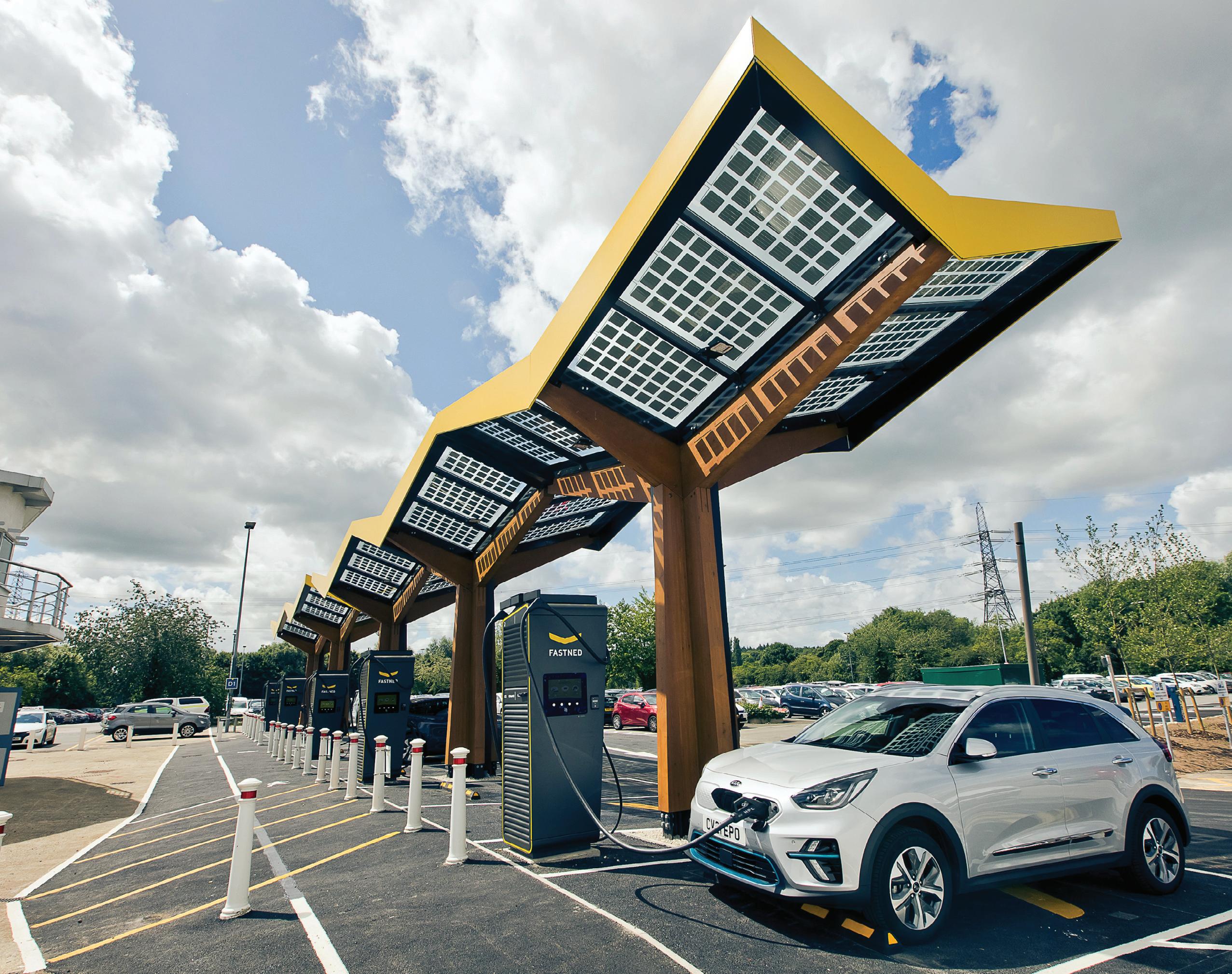

We are connecting the dots of a new mobility revolution that is transforming our towns and cities.

With the broadest end-to-end portfolio of intelligent traffic management solutions, we work with cities, highway authorities and mobility
operators to make their road networks and fleets intelligent, enhance road safety and improve air quality.
It’s time to make the world a better place. We are ready. Are you?
Editorial
Managing editor:
Mark Moran Tel: 020 7091 7871
mark.moran@landor.co.uk
Production and design production@landor.co.uk
Advertising, sponsorship, marketing and exhibition packages
Jason Conboy Tel: 020 7091 7895 jason@landor.co.uk


Subscriptions
Christina Pierre Tel: 020 7091 7959 subs@landor.co.uk
Accounts
Irina Cocks Tel: 020 7091 7854 irina.cocks@landor.co.uk
Business manager
Rod Fletcher Tel: 0191 280 1410
Printed by: Pensord Tram Road, Pontllanfraith, Blackwood NP12 2YA
Published by: Landor LINKS Ltd, Apollo House, 359 Kennington Lane, London SE11 5QY
© Landor LINKS Ltd 2022
www.landor.co.uk
Registered members of:

The Independent Press Standards Organisation www.ipso.co.uk
The Professional Publishers Association www.ppa.co.uk
The UK is now home to an increasingly deep network of public chargepoints provided in car parks, at park & ride sites and rail stations, on motorways, in supermarkets and along the kerbside.


According to the Zap-Map website, at the end of June 2022 there were 32,663 charging points spread across 19,960 charging locations. This represents a 34% increase in the number of charging devices since June 2021. In May, 829 new charging devices were added to the Zap-Map database.
Government investment in the rolling out of charging infrastructure so far runs to an estimated £1.5bn. Looking forward, there is a need to ensure that public EV charging is a genuine national network in which currently underserved regions and communities are catered for. This means rural and marginal locations, which are possibly less attractive to commercial chargepoint providers, become areas where public funding will become especially important in future.
However, there are positive signs that the private sector is increasingly willing to underwrite the provision of chargepoints and creation of charging hubs. But there are other ways in which companies can help fill in the gaps. For example, the Zap-Map figures do not include the many chargepoints installed at home or at workplace locations, which are estimated to be more than 400,000. Hopefully more of these chargepoints can be available to the public via community charging services.
Mark Moran Editor
The UK government has pulled the plug on grants to support the purchase of plugin cars. The government says the focus of its support funding will now move to other vehicle types and to expanding the UK’s charging infrastructure.
The government claims the Electric Vehicle Plug-In Car Grant (PICG) scheme has helped create a mature market for ultra-low emission vehicles, helping to increase the sales of fully electric cars from less than 1,000 in 2011 to almost 100,000 in the first five months of 2022 alone. There were 39,000 new electric vehicles (EV) registrations in March 2022, more than in the whole of 2019.
Battery and hybrid electric vehicles now make up more than half of all new cars sold and fully electric car sales have risen by 70% in the last year. They now represent 1-in-6 new cars joining UK roads.
The government had signalled that the plug-in car grant was temporary and previously confirmed funding until 202223. It said that successive reductions in the size of the grant, and the number of models it covers, have had little effect on rapidly accelerating sales or on the continuously growing range of models being manufactured.
As announced in the autumn statement, some £300m in grant funding will now be made available to extend plug-in grants to
There are nearly as many workplace chargepoints than public chargers for electric vehicles in the UK – nearly doubling the amount of infrastructure available to drivers. A report on workplace chargers has found there are 33,000 charging sockets at workplaces.
Mobility services group Transport & Environment (T&E), which commissioned consultancy Cenex to conduct the study, said that over a third of car and van miles are for commuting and business purposes, highlighting the need to require landowners to install charging where people work.
The growth of the EV fleet is being mirrored by the growth of chargepoint installation rates. Some 7,600 public chargers were installed in the last year.
boost sales of specific plug-in vehicle types such as taxis, motorcycles, vans and trucks and wheelchair accessible vehicles.
The government will now focus its major funding towards addressing barriers to the EV transition, including public charging and supporting the purchase of other road vehicles where the switch to electric requires further development. The shift in focus will also help allow government funding to target expanding the public chargepoint network, helping to eradicate “range anxiety” and ensure the transition to zero-emission transport is easy and convenient for all drivers across the UK. The government has already committed £1.6bn to building the UK’s public chargepoint network.
The government said significant savings that can be achieved in running costs for electric cars compared to petrol or diesel equivalents can often exceed the current £1,500 value of the grant, and electric car drivers will continue to benefit from generous incentives including zero road tax and favourable company car tax rates, which can save drivers over £2,000 a year.
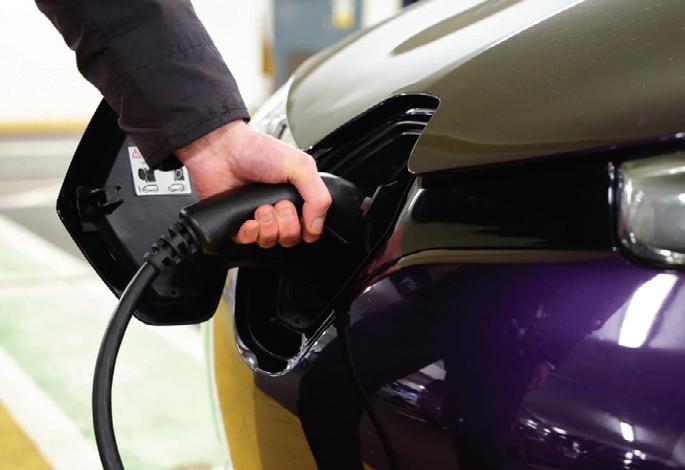
All existing applications for the grant will continue to be honoured and where a car has been sold in the two working days before the announcement, but an application for the grant from dealerships has not yet been made, the sale will also still qualify for the grant.
Transport minister Trudy Harrison said: “The government continues to invest record amounts in the transition to EVs, with £2.5bn injected since 2020, and has set the most ambitious phase-out dates for new diesel and petrol sales of any major country. But government funding must always be invested where it has the highest impact if that success story is to continue.
“Having successfully kickstarted the electric car market, we now want to use plug-in grants to match that success across other vehicle types, from taxis to delivery vans and everything in between, to help make the switch to zero-emission travel cheaper and easier.”
Since its inception in 2011, the government’s plug-in car grant has provided over £1.4bn and has supported the purchase of nearly half-a-million vehicles.
A public evaluation report by Office for Zero Emission Vehicles highlights that while the plug-in car grant was vital in building the early market for electric vehicles, it has since been having less of an effect on demand, with other existing price incentives such as company car tax, continuing to have an important impact. The report also found the plug-in van market will benefit from grant incentives that support businesses and their fleets in making the switch.
Local authorities will be issued guidance on the preparation of local transport plans (LTPs) in the autumn. The guidance will set out all the Department for Transport’s (DfT) objectives for local transport in one place.
The DfT has confirmed there will be a requirement for a local electric vehicle charging strategy to be published as a detailed supporting document accompanying each LTP.
The DfT’s head of funding reform and delivery Nicole Barton has explained LTPs should include a detailed action plan setting out how public chargepoints will be provided, supported and aligned with the other
transport and energy needs of the area.
Speaking at last month’s New Era for LTPs event Barton said that, in line with the government’s Taking Charge: the electric vehicle strategy document, the document should include:
• agreed ownership and resourcing of the planning and delivery of EV charging infrastructure roll out
• commitments on the scale and type of chargepoint deployment they will prioritise to meet local needs
• a clear plan for engaging and supporting chargepoint planning and delivery across all its constituent councils
• a commercial approach which maximises opportunities to draw in private investment
• early engagement with local businesses about the needs of their fleets, and consideration of how these can be addressed
• working with local electricity network operators to understand electricity network considerations.
• consideration of how chargepoints will be integrated into their environment and relate to other transport considerations (e.g active travel, bus prioritisation
• consideration of ease of payment at public chargepoints.
There is little evidence that the UK government is delivering on its own ambitious commitments to reach net zero by 2050, says the independent Climate Change Committee (CCC). A progress report published by the committee finds major failures in delivery programmes towards the achievement of the UK’s climate goals.
Last year, the CCC applauded the government for setting ambitious targets and launching a new Net Zero Strategy. Policies are now in place for most sectors of the economy, but its review of progress finds “scant evidence” of delivery against these headline goals so far. There are some areas where progress has been made, says the CCC, but in most areas the likelihood of under-delivery is high.
The CCC calls this is a “high-wire” approach to net zero. For the UK’s climate lead to be effective, the world must have confidence that it will keep its promises and that it has a clear and effective programme to achieve its commitments.
In the area of domestic heating, the CCC says that the UK government must drive down energy bills and reduce climate-warming emissions by insulating more homes. The committee estimates consumers are paying £40 extra a year on bills because of previous cuts to the home renovation programme. The committee says ministers must harness the Ukraine fuel crisis to push ahead with renewables.
Liberty Charge is warning of a £1.5bn gap in government funding for electric vehicle (EV) infrastructure. The public chargepoint operator says the government’s £450m Local Electric Vehicle infrastructure (LEVI) fund falls short of real-life costs.
In total, the government has committed just under £1.5bn in funding for rapid and transit charge points across the UK. Liberty Charge believes this is just half of what it will cost to install the 300,000 public chargepoints needed to electrify the UK and could leave Britain at risk of missing its net zero goals.
Liberty Charge believes private sector firms are able to fund the installation and maintenance of chargepoints across many parts of the UK. It is urging the government to redirect its £450m LEVI fund to where it is needed most, such as remote, rural regions and areas of higher
Number of UK new electric car sales and market share of total new car sales
The committee praises the government on two issues: a renewable energy programme which will save people £125 a year on bills by 2030; and promoting electric cars, although more chargepoints and electric vans are needed.
In a 600-page assessment, the CCC has revamped its framework for monitoring the UK’s climate progress, focussing on the changes needed on the ground to achieve net zero. Across the economy, the CCC has developed detailed new progress indicators to assess the risks of net zero delivery. CCC chairman Lord Deben said: “The UK is a champion in setting new climate goals, now we must be worldbeaters in delivering them. In the midst of a cost-of-living crisis, the country is crying out to end its dependence on expensive fossil fuels. I welcome the government’s restated commitment to net zero, but holes must be plugged in its strategy urgently. The window to deliver real progress is short. We are eagle-eyed for the promised action.”
UK emissions are now almost half (47%) their 1990 levels. Emissions rose 4% in 2021 as the economy began to recover from COVID-19 but were still 10% below 2019 levels. Further progress must be led by government policies with clear direction, credible delivery mechanisms and suitable incentives to shape private sector action. In no sector of the economy is this yet complete.
The CCC report makes over 300 recommendations for filling out policies over the next year, reflecting the scale of the task at hand as the government moves from strategy to implementation.
The areas of strongest progress are backed and led by well-designed government policy:
• Deployment of renewable electricity: Emissions from electricity generation have fallen by nearly 70% in the last decade. With offshore wind, business has shown that given the right market conditions and support it can cut costs dramatically and deploy low-carbon solutions rapidly.
• Electric cars are being adopted in greater numbers each year: Their rise is already ahead of CCC and government growth projections, showing that consumers and households are willing to adopt low-carbon options when offered a cost-effective, good quality product.
In other areas, low-carbon options remain in their infancy. The CCC said policy has not yet begun to guide the promised private sector action in areas such as energy efficiency in homes and agriculture.
deprivation where the commercial case is not viable. This will ensure government funding is concentrated in creating a comprehensively nationwide charging network that leaves no-region and no-one behind.
The chargepoint operator also believes that funds should be used to significantly amplify the £50m the government has set aside for the local authority resourcing.
Neil Isaacson, chief executive of Liberty Charge, said the private sector should and can handle the funding gap needed to meet chargepoint targets.

“Local authorities urgently need more resources and funding to boost electric vehicle infrastructure, if the UK is to meet the deadline it has set itself of ending sales of new petrol and diesel cars by 2030,” he said.
Liberty Charge has commissioned research and will be releasing results
in a white paper in the coming weeks. The most fundamental finding from the report is how chronically underresourced local authorities are. Just 14% have dedicated EV infrastructure
resources, 3% have none at all. On average three people work a collective 15 hours per week each on planning, commissioning and implementation. That is less than half a full-time employee devoted to EV infrastructure roll out. “I understand they’re under-resourced, but the government will need to go further and faster if it’s really serious about hitting its net zero target,” Isaacson said.
Liberty Charge is also pressing for a level playing field on VAT for public charging. Currently on street charging is set at 20% VAT compared to only 5% for those with off-street chargepoints. For many people, particularly the disadvantaged, this is adding costs that put electric vehicles out of their reach. “Without the right size and scale of public charging infrastructure that gives confidence to households that don’t have off-street parking, they just won’t turn to electric vehicles.”
Current programmes will not deliver net zero, warns CCC
UK faces £1.5bn funding shortfall, warns Liberty ChargeNeil Isaacson
The average price of charging an electric car on a pay-asyou-go, non-subscription basis at a publicly accessible rapid charger in Great Britain has increased by 21% to 44.55p per kilowatt hour (kWh) since September 2021, according to figures analysed by the RAC’s new Charge Watch service.
RAC Charge Watch is an initiative designed to monitor the cost of public electric car charging in the UK. Run in association with the national FairCharge campaign, Charge Watch follows the motoring organisation’s Fuel Watch service which records petrol and diesel prices.
The 7.81p per kWh increase, from 36.74p at the end of last summer, means that the average cost to complete an 80% rapid charge of a typical family-sized electric car with a 64kWh battery has increased by £4 over this period, from £18.81 to £22.81 now (cars
revert to slower charging speeds beyond 80% to preserve battery health). In contrast, the cost of filling a 55-litre family car from empty to 80% has increased by a huge £14.54 since last September, from £59.67 to £74.21 – a 24% increase.
The RAC’s analysis shows that it now costs on average 10p per mile to charge at a rapid charger, up from 8p per mile last September. This is nearly half the cost per mile compared to filling a petrolpowered family car, the cost of which has risen from 15p per mile since the end of last September to 19p per mile now. The cost per mile for a
similarly sized diesel-powered car is higher at nearly 21p.
The average price of charging at the quickest ultrarapid chargers – which have a power output of 100kW-plus and can deliver a charge to a compatible vehicle in as little as 20 minutes – has increased by a greater margin of 16.76p per kWh, from 34.21p per kWh in September to 50.97p in May. This means the cost to charge a vehicle to 80% has risen from £17.51 to £26.10.
However, this is still £48 cheaper than filling a petrolpowered car to 80%, although electric car drivers do not get quite as many miles from an 80% charge as drivers of petrol

cars do from an equivalent fillup of a tank of fuel.
The RAC said the price increases facing drivers of electric cars using public chargers can be explained by rises in the wholesale cost of electricity, which itself is driven by hikes in the cost of gas. A considerable proportion of the UK’s electricity is generated by natural gas-fired power stations.
Ofgem figures show that the wholesale cost of gas doubled between the end of September 2021 and the end of March this year, with wholesale electricity prices rising by around 65% over the same period.
InstaVolt has received £110m in senior debt financing from Santander, Lloyds Bank, Investec, Natixis and NIBC to continue its expansion of rapid electric vehicle (EV) charging infrastructure throughout the UK.
The funding comes three months after EQT Infrastructure acquired InstaVolt.
European fast charging company Fastned has raised nearly €23m with the issue of new bonds. In addition, investors have extended over €7m worth of investments from earlier issues, bringing the total issued amount in this round to nearly €30m. The newly issued bonds mature in December 2026.
From 10 May to 12 June, investors could subscribe to the bonds with 5% interest and a maturity of 4.5 years. Holders of Fastned bonds bought before April 2019 could extend their investment by
exchanging those bonds for bonds in the new issue. Including earlier extensions this has reduced the repayment obligation for Fastned in 2022 by nearly €10m.

Michiel Langezaal, chief executive of Fastned, said: “The bond issue allows us to continue to invest in the expansion of our Europe-wide network, bringing more freedom to electric drivers. EV sales are hitting all-time highs and on top of that, EU lawmakers voted to support a proposed ban on the sale of new petrol and diesel cars from 2035.”
Adrian Keen, InstaVolt’s chief executive officer, said: “Having such prestigious banks come together to provide this facility is a sure sign of confidence in InstaVolt and the opportunity provided by the charging infrastructure industry more generally. This funding will form an important part of our strategy to expand our network within the UK and support our country’s continued green transition: a journey which
requires organisations and bodies to come together wherever possible.
“InstaVolt has been at the forefront of the growth in public charging infrastructure, providing industry leading levels of reliability at fantastic locations across the country. We are witnessing a rapid transition to electric vehicles, and it is of fundamental importance that the infrastructure is in place to support that.”
InstaVolt has a vision to build a nationwide network of 10,000 rapid EV chargers by 2032.
This year, InstaVolt was named the UK’s best public charging network by Zap-Map for the fourth year in a row and won the EVIE Private Sector Infrastructure Strategy of the Year award for the second year in a row.
Three electric vehicle HyperHubs will be coming online in York over the coming months. The first hub was opened in midJune adjacent to the Monks Cross park & ride site. A second is set to open next to the Poppleton Bar P&R site in the summer. A third site is due to open on a site near the city centre.
The projects are the result of a partnership between the City of York Council and EvoEnergy. The Monks Cross hub features four 175kW ultra-rapid chargers (which can be upgraded to 350kW when more electric vehicles can charge at this rate), four 50kW rapid chargers, with an adjacent area having 30 7kW chargers for park & ride users.
The hub has a solar canopy which allows the site to generate its own renewable energy which can be stored in the Tesla Powerpack batteries at the hub, helping to reinforce the grid.
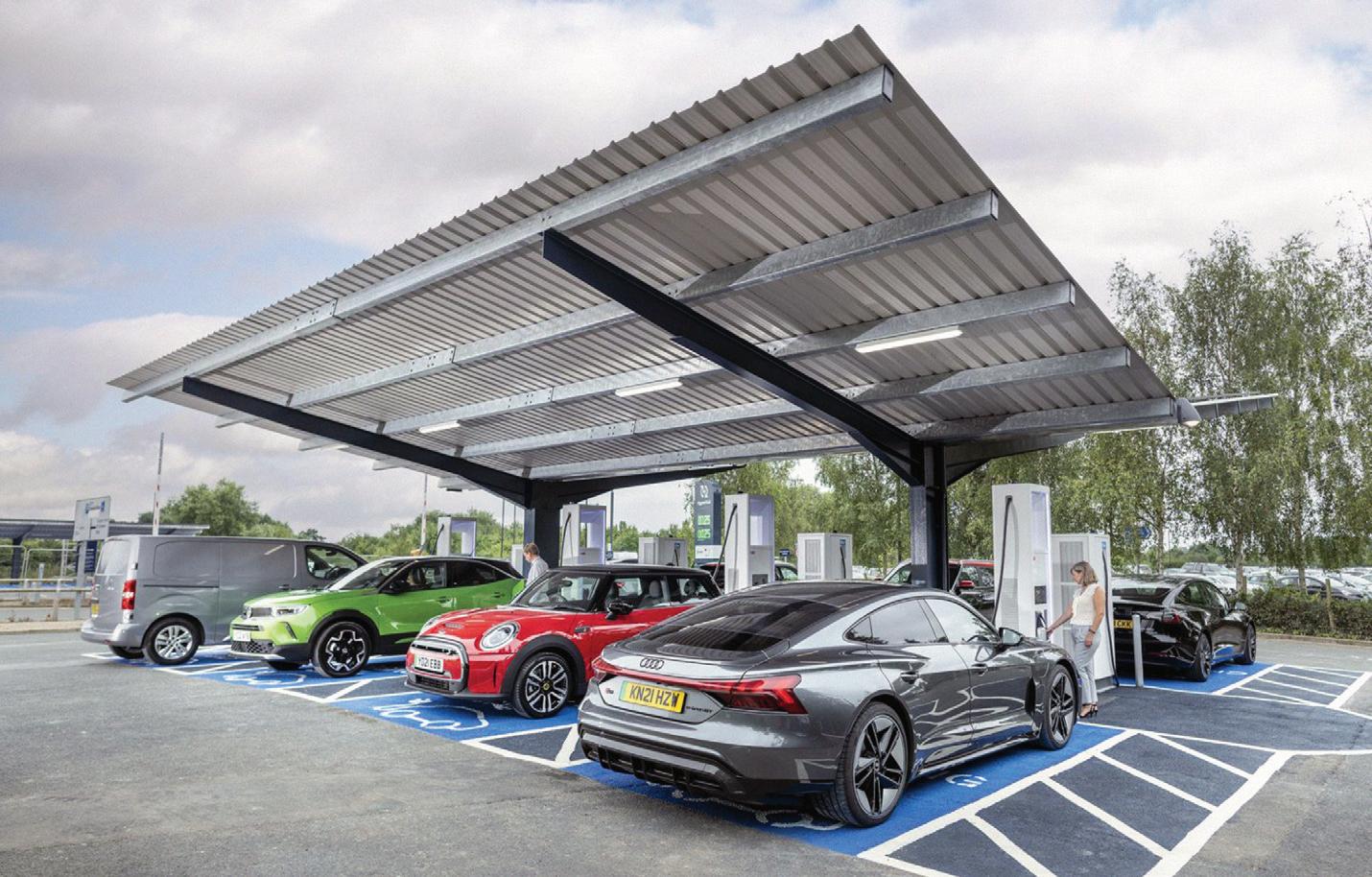
The ultra-rapid and rapid chargers offer contactless payment. Cars and vans can access the chargers, and the facility has been designed with no kerbs to allow disabled access. Protection from the
weather is provided by the solar canopy and all of the electricity supplied from the National Grid will be generated by renewable sources.
A key element behind the development of the HyperHubs was the production of an electric vehicle charging strategy by the City of York Council. This looked at a wide
range of issues in order to ensure that the HyperHubs met the needs of residents, fleets, commuters and through traffic.
The convenient location of the charging hubs was a central part of the strategy, with the first two HyperHub sites being located off the ring road next to established park & ride sites.
An online platform that will encourage EV usage and car sharing in Derbyshire has been awarded £100,000 funding from sub-national transport body Midlands Connect.

Independent research consultancy Cenex, working in partnership with Derbyshire County Council, has been announced as the winner of Midlands Connect’s Future of Rural Mobility competition, receiving £100,000 of funding to develop its proposal for an online electric vehicle (EV) charging and car sharing platform.
Once developed, the online platform will allow EV users across Derbyshire to ‘rent out’ their private chargepoints, giving motorists access to more chargers to power up their vehicles. The platform will also promote car sharing by providing opportunities for people to rent out their cars when they are not using them, meaning that residents without their own private vehicle can get around more easily.
It is hoped the project will encourage sustainable travel and open up opportunities for EV ownership to groups who may not have benefitted from access to local charging points before, particularly households without off-street parking.
The online platform will initially be targeted towards residents and local businesses, with hopes to expand it to tourists in time.
Midlands Connect’s Future of Rural Mobility competition received submissions from businesses which were asked to present new ideas that could help solve the social, environmental, and economic issues caused by poor connectivity in rural areas. The winner was announced at Midlands Connect’s Rural Mobility
Conference in Melton Mowbray. The conference included panels from competition winners and runners up, as well as the Department for Transport, senior politicians and transport experts.
Midlands Connect chief executive Maria Machancoses said: “Poor transport connectivity can be a challenge for rural communities, with residents often experiencing worse access to amenities and services such as schools, workplaces or
hospitals. Our rural mobility competition was created to address these challenges and to create innovative solutions that would enhance transport connectivity in isolated communities.”
Cenex chief executive Robert Evans said: “Our digital mobility hub has the potential to change the way Derbyshire residents think about transport. By giving people access to information on services such as car sharing we can improve transport connectivity and reduce harmful carbon emissions from road transport.”
Cllr Tony King, cabinet member for clean growth and regeneration at Derbyshire County Council, added: “We welcome the support given by Midlands Connect in tackling rural connectivity, something that many counties across the Midlands are challenged with. Lower population density often leads to patchy public transport in rural areas and for people without access to a car, this can lead to isolation.
“The platform proposed by Cenex has the potential to change our residents’ lives – particularly those who do not have their own vehicle or share with other members of their household, as well as those considering switching to an electric vehicle.”
York’s first HyperHub opens at Monks Cross park & ride
The newly opened Energy Superhub Oxford provides fast and ultra-rapid charging for 42 vehicles and has the capacity to charge up to 400
The Energy Superhub Oxford has been officially opened. The charging hub will initially offer fast and ultra-rapid charging for 42 vehicles at once at Oxford’s Redbridge park & ride.
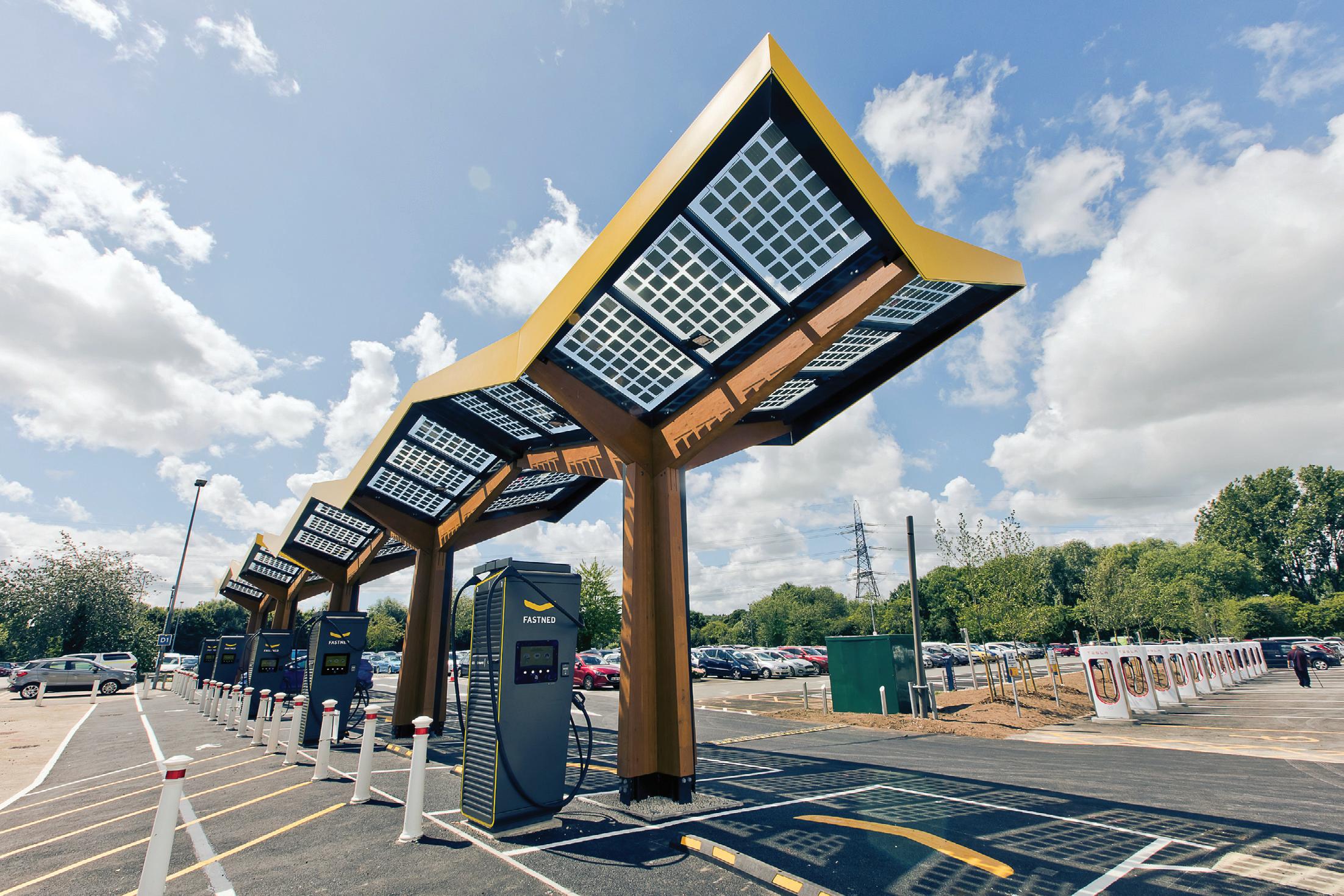
The charging hub is being powered entirely by renewable energy. With 10MW of installed capacity on site, the hub can scale up with electric vehicle (EV) adoption to provide charging for 400 vehicles, helping to support the estimated 36 million EVs expected on UK roads by 2040.
The £41m urban decarbonisation project was delivered by Pivot Power, together with a consortium of global partners and part-funded by the UK government. Pivot Power, part of EDF Renewables, has worked alongside Oxford City Council, Fastned, Tesla Superchargers and Wenea.
Matt Allen, chief executive and cofounder of Pivot Power, said: “Urban decarbonisation is ground zero for the immediate emissions reductions needed to tackle the climate crisis. Energy
Superhub Oxford provides a vision of the future, today. By delivering a worldleading project that cuts emissions across transport, power and heat, we are breaking new ground to help the UK reach net zero sooner.”
Cllr Imogen Thomas, cabinet member for Zero Carbon Oxford and climate justice at Oxford City Council, said: “Oxford has a history of being ambitious as we look to adopt new and exciting transport approaches in our city.
Redbridge was the location of the country’s first full running park & ride in 1973, and now almost 50 years later, we are home to Europe’s most powerful electric vehicle charging hub. In order to achieve a Zero Carbon Oxford by 2040 we need to encourage uptake in electric vehicles, and drivers want to know that they can charge their vehicles quickly and efficiently.”
The opening event on 7 July was attended by Trudy Harrison MP, transport decarbonisation minister, who said: “Electric vehicles form a key part of our
strategy to decarbonise transport, so I’m pleased to see Europe’s most powerful EV charging hub opening in Oxford. Both the government and industry, working together, are investing billions in projects like this to help provide the infrastructure to support the UK’s electric revolution and soaring EV sales. This, in turn, will help us decarbonise transport, create high skilled jobs, and provide cleaner air across the UK.”
European EV rapid charging company
Fastned has initially installed ten charging bays at the Superhub with 300kW of power available, capable of adding 300 miles of range in just 20 minutes for hundreds of EVs per day.
Michiel Langezaal, chief executive of Fastned, said: “The launch of Fastned’s station at Energy Superhub Oxford, our 12th station in the UK, marks another important milestone in our mission to revolutionise the charging experience for British EV drivers, by giving them electric
freedom. Since we opened the UK’s first public ultra-rapid charging station in Sunderland in 2019, Fastned has been committed to using our experience from across Europe to accelerate the EV revolution in the UK. Just a month ago, drivers started using our first station in London, and in May we opened the largest ultra-rapid station in Scotland in Hamilton.”
EV charging services providers Wenea has deployed twenty 7-22kW charging bays. Work to install Wenea’s EV charging stations was carried out by ODS – a wholly owned subsidiary of Oxford City Council. Jose Contreras, head of Wenea UK, said: “Wenea’s objective is to enable electric mobility for everyone in order to reduce overall emissions. Transport decarbonisation will only be achieved through the collaboration of public and private transport. The project in Redbridge park & ride is the perfect example. Wenea’s offer will cater for electric vehicle users with dwell times of several hours, typically commuters or tourists who prefer to leave their EVs in Redbridge and enter the city via public transport.”
A further 12 250kW Tesla Superchargers will be available for Tesla owners.
Pivot Power’s network can be expanded to key locations throughout Oxford to decarbonise public and private transport, taxis and commercial fleets, supporting Oxford’s net zero 2040 target, as well as providing infrastructure for the pilot Zero Emission Zone (ZEZ), a scheme that applies fees to any non-electric vehicle entering the central zone.
The site is directly connected to National Grid’s high voltage transmission network via a four-mile underground cable, which will deliver 10MW of power to quickly and simultaneously charge hundreds of EVs without putting additional strain on the local electricity network or requiring costly upgrades.
A substation has already been installed at Oxford Bus Company’s Watlington Road depot, ready to support the company’s plans to introduce over 100 electric buses in the coming two years.
As part of the project, Energy Superhub Oxford has also supported the decarbonisation of Oxford City Council’s fleet of maintenance vehicles, managed by ODS. In total, Energy Superhub Oxford has contributed almost £900,000 towards the procurement of 40 EVs, including cars, vans, road sweepers, tipper trucks and the city’s first all-electric bin lorry.
It is envisaged that Energy Superhub Oxford will provide a blueprint for cities around the world to simultaneously scale up green transport, power and heating.
It will unlock significant emissions
reductions across power, heat and transport as part of the programme to decarbonise Oxford by 2040 – saving 10,000 tonnes of CO2 every year, equivalent to taking over 2,000 cars off the road, increasing to 25,000 tonnes by 2032.
The opening event also marked the activation of Energy Superhub Oxford’s hybrid battery system, developed by Pivot Power. This is designed to underpin local and national clean power systems and support the UK’s transition towards a zero-carbon energy system.
The battery system, which stores renewable energy at times of high supply, will provide essential flexibility to the UK’s grid as renewable energy is scaled up. During periods when the sun does not shine or the wind does not blow, the battery will discharge, helping to ensure electricity is secure and reliable throughout the day.
Energy Superhub Oxford (ESO) is one of three demonstrator projects part-funded by the UK government’s Industrial Strategy Challenge Fund through the Prospering from the Energy Revolution programme, which is enabling innovation in smart local energy systems.
The programme is delivered by Innovate UK –part of UK Research and Innovation – and contributed £10.3m to the ESO project. ESO – a collaboration between Pivot Power, Habitat Energy, Invinity, Kensa, Oxford University, and Oxford City Council – showcases rapid electric vehicle charging, hybrid battery storage, lowcarbon heating, and smart energy management to improve air quality and accelerate Oxford’s zero-carbon journey.
The ESO project forms what will is intended to be a nationwide network of Energy Superhubs developed by Pivot Power that combine transmission-connected batteries and power infrastructure for EV charging to enable more renewables and accelerate the decarbonisation of transport.
It combines a 2MW/5MWh vanadium flow battery from energy storage leader Invinity Energy Systems with a 50MW/50MWh lithium-ion battery from global technology company Wärtsilä to deliver an innovative energy storage solution that can balance the intermittency of renewable energy.
The system will be controlled and managed by Wärtsilä’s GEMS Digital Energy Platform and optimised by Habitat Energy’s AI-enabled battery trading system.
Pivot Power plans to deploy up to 40 Energy Superhubs across the UK, with the next two projects already underway in Coventry and Sandwell, to the northwest of Birmingham.
Once complete, it is estimated that network could provide almost 10% of the energy storage that the UK is predicted to require by 2035.

As the flagship Superhub city, Oxford is seeking to show how local councils can accelerate their net zero plans. It recently set out its plans to reach net zero by 2040 and reduce emissions by 40% by 2030.
Energy Superhub Oxford has also supported the installation of over 60 ground source heat pumps for social housing properties in Oxford, helping to alleviate the reliance on fossil fuel-based heating that has pushed energy prices to record levels and placed increased strain on working families. Residents who have already received ground source heat pumps in Oxford have reported running cost savings of over 50%.
The project is also demonstrating the use of remote control to target times when renewable energy is most plentiful and lowest carbon. This approach will reduce future electricity bills as heat pump installations scale from thousands to millions over the next decade.
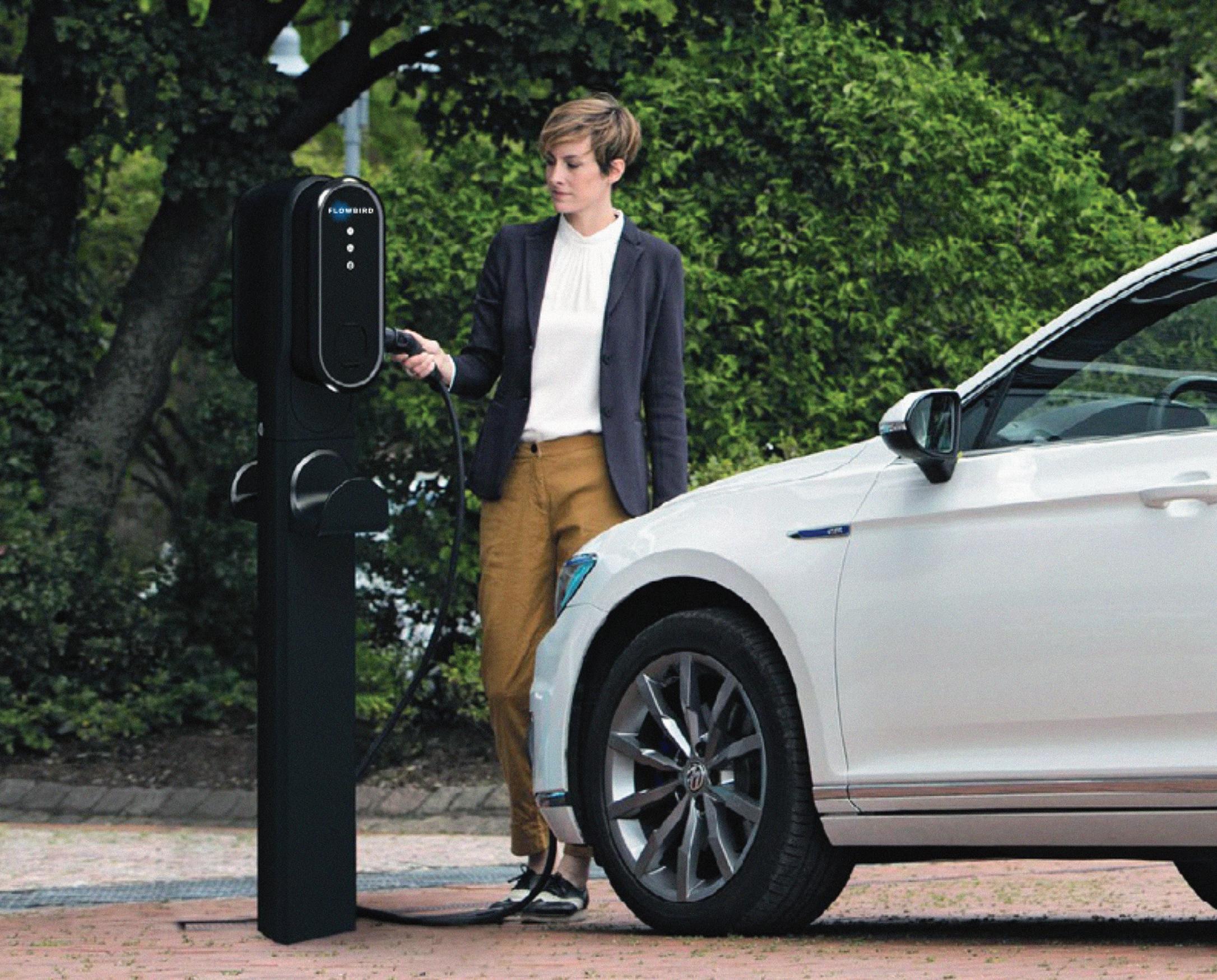
Flowbird research reveals polarised attitudes among the public to payment technology and apps for parking and EV charging, says Danny Hassett
It is probably fair to say parking is undergoing its biggest disruption ever.
On one hand, this is driven by digital technologies. On the other, by the need to deploy electric vehicle (EV) charging infrastructure at scale in parking spaces.
Whilst both are important, we at Flowbird have worried for some time that both are being driven too much by technology capability, and not enough by user need. To understand what that user need really is, we recently commissioned YouGov to survey 2,000 people in the UK.
In a world where everyone is promising a silver bullet to complex problems, our most interesting finding was that there was no single answer. People are different. When asked the same question, different people responded in different ways. The
impact is clear, we need to cater to a range of different needs.
Do people like parking apps? Yes and no. One of our most nuanced findings was on parking apps (for transparency, Flowbird is one of the companies offering such an app).
Our survey found 22% of respondents agreed that parking apps had made their lives easier. It also found 28% disagreed (the rest were ‘don’t knows’ or on the fence). Some drivers may find that surprising for such an obviously useful technology. But some people do not have smartphones, or struggle with apps.
Others don’t want to hand over their personal data. This seems particularly true amongst older users, our survey found retirees disliked parking apps at a
higher rate than the general population (39%). In April 2022 this issue hit national headlines when a group of elderly residents in Kent branded their council ageist for only offering app payment options.

Related to apps is the issue of how people want to pay.
Whilst many are clearly happy to pay with apps, 56% of respondents said they still expect to still pay for parking via a physical terminal some of the time, rising to 63% for retirees. This loosely echoes a 2021 study by the British Parking Association which found 75% of parking payments still use cash.
Some objections are not technological,
but to do with privacy or convenience. Some people are fine with one app for their regular car park, but do not want a new sign up every time they go somewhere new (66% of respondents found it frustrating to download multiple apps for different car parks).
An alternative ‘smart’ solution could be a QR code that takes the driver straight to a payment portal, where they enter their numberplate and card details, with no sign up, download, or personal data sharing. In our survey 55% said they liked the sound of this option.
Together, the views on apps and payments underline the importance of a multi-option strategy to ensure everyone is included. Our view is that all car parks need to include a mix of physical and digital options, with that mix changing gradually as user needs evolve. Rather than replacing old approaches, operators should add new options, then follow usage data on both, and only remove older options if they become redundant.
Parking apps have been much discussed as the disrupter of parking, but other digital tools could be useful too.
Flexible parking options could be one. If tickets are managed digitally, there is no reason season tickets options could not be expanded to offer caps or incremental discounts (tracked by ANPR or scanning a registered payment card). In our research, 19% wanted more flexible season tickets –not an overwhelming number, but not insignificant.
Our research also found 33% would find multi-modal journey options useful – e.g. booking parking, bus, and bike hire in a
single transaction. Such joined up approaches also allow discounts and price caps, saving people money. An Economist article in May noted that “outside London, bus, train and tram services are often disjointed. The result is confusion and greater cost for the public”.
Such services have been slower than payment apps because they require behind-the-scenes platforms – which track users through multiple payment points based on an identifier (payment card, numberplate), manage multi-party payment splits, and link to enforcement –to create seamless user experiences.
Many parking operators are deploying this type of digital platform, and once it is in, it opens options to provide these indemand (and monetisable) services. Furthermore, when linked via a single platform, such services can be booked not just online, but via payment terminals with touchscreens. In fact, 31% said they would find it useful to be able to use smart terminals to book services other than parking, a figure that would no doubt rise if such services became commonplace.
What do people want from EV charging infrastructure?
Finally, we looked at the next big parking transformation, EV charging, where 52% of our respondents said more parking spaces should have EV charging points (only 7% disagreed, the rest were neutral). This varied little by region.
Like parking, we found that user experience of booking and payment was important, with varied expectations.
Some 66% of existing EV drivers said current payment schemes were too complicated (though EV driving survey respondents were low, so this should be interpreted with caution).
Nonetheless, there was appetite for simple options: 64% of all respondents (and 94% of EV drivers) said there should be an on-the-spot payment option for EV charging (i.e. no sign up) and 42% said there should be an option to pay with cash. Where chargepoints lack functionality for such things, they could be
Strongly agree 45%
Tend to agree 21%
Neither agree nor disagree 14%
Tend to disagree 3%
Strongly disagree 2%
Don’t know 15%
linked to smart parking terminals to offer such options, underlying the importance of a joined-up parking and EV approach.
Whilst both digital technologies and EV charging will be critical to the future of parking, our research highlights that they must be deployed according to user need.
Many of these products are good, but it sometimes feels like their business models are inspired by the ‘best-product-wins’ world of consumer tech. We feel this is wrong for this market. These products must be deployed into a public service (parking) or a managed infrastructure transition (EV charging). They need to integrate into a complex ecosystem and to work for everyone, not just the wealthy or the tech savvy.
Local authorities – whose duty is to their residents and community – must select and deploy new technologies as part of a strategy, aligned to the evolving user needs.
Flowbird has operated around the world for decades and we recognise that this new raft of technologies does indeed represent unprecedented change for parking. But the underlying principle has not changed: infrastructure needs to be designed for a broad range of user needs. As our research shows, those needs are diverse.
We hope our report will provide valuable insight to local authorities to help them understand what users want, and shape long term strategic decisions about the use of parking space.
Strongly agree 8%
Tend to agree 14%
Neither agree nor disagree 24%
Tend to disagree 12%
Strongly disagree 17%
Don’t know 25%
Flowbird’s total cohort for this research was 2,085 respondents who were a demographically representative sample of the UK population.
Driving habits were: 67% petrol or diesel drivers, 2% electric, 4% hybrid, and 25% non-drivers, ~2% rare options including hydrogen and biofuels.






The UK’s postcode lottery of public chargepoints may be contributing to charging anxiety among potential electric vehicle (EV) drivers, but suggests the conundrum of a lack of overall public chargepoints is a common misconception
The creation of a robust, reliable, and fit-for-purpose public charging infrastructure that enjoys the full confidence of EV drivers is central to mainstream adoption of electric cars.
Forecasts outlined by the Competition and Markets Authority (CMA) suggest that up to 480,000 public charging points will be needed across the UK by 2030.
In addition, according to estimates published by the European Commission, every ten electric vehicles on the road require one public charger solution. Therefore, with 460,000 battery electric vehicles (BEVs) currently on the road in the UK, the present availability of 31,000 public chargers, as of April 2022, might appear insufficient.
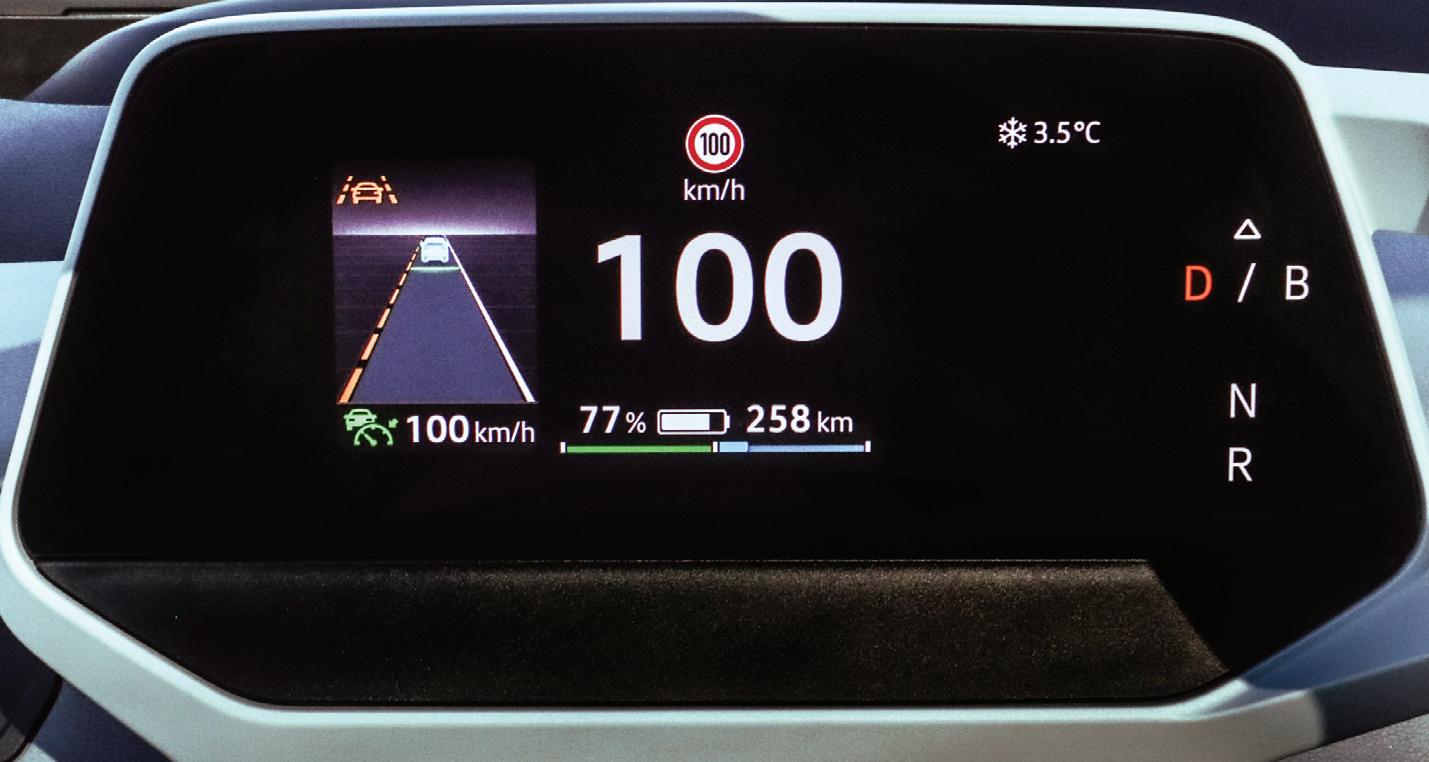
However, these statistics seem to ignore one vitally important factor: there are also approximately 300,000 home chargepoints installed across the UK, which leaves just 160,000 BEV drivers without a home charger. This vastly reduces the dependency on the public network.
If it is only the remaining 160,000 BEV drivers that need regular access to public chargers, the 31,000 currently available means the UK has almost double the suggested requirement outlined by the European Commission.
Are there still issues with the UK’s charging infrastructure? Yes – but it’s not the number of public chargers that is the concern – it is the accessibility, reliability and geography of chargepoints that require attention and investment from both the automotive industry and the government.
Figures from the Department for Transport up to July 2021 demonstrate that London and the South East benefit from a disproportionately higher number of public charging points per capita when compared with other areas around the UK.
Based on public charging points per 100,000 people, drivers in London and the South East enjoy access to 128 chargepoints. This is more than Wales (29), Scotland (47) and Northern Ireland (17) combined.
With discussions underway concerning the government’s ‘levelling up’ agenda, the North also falls short when compared with the capital and the South East.
This fact is demonstrated by figures showing the North West has 22 public charging points per 100,000 people, the North East has 33 and Yorkshire & The Humber just 21.
are contemplating longer journeys across the nation.
It is hoped that the government’s £450m Local Electric Vehicle Infrastructure (LEVI) fund, which will fund projects such as EV hubs and on-street charging solutions, will go some way to alleviating the regional disparities, but concerns over a lack of overall public chargepoints are perhaps misplaced.
Moreover, with figures from the Society of Motor Manufacturers & Traders (SMMT) showing that 2021 saw the biggest annual increase in EV registrations with 191,000 BEVs registered, taking the total on UK roads to more than 395,000 – an annual growth of 92% from 2020 – the nationwide roll-out of public chargepoints must keep pace with demand for electric cars.
The current postcode lottery when it comes to accessing a convenient public charging point may also be contributing to a new driver phenomenon – ‘charging anxiety’.
The Volkswagen Financial Services UK data insights team believes ‘range anxiety’ among consumers – when drivers fear electric vehicles would not travel far enough on a single charge to get them where they needed to go – has now been replaced by ‘charging anxiety’. This translates into worries that the current public charging infrastructure is not widespread, accessible or reliable enough to alleviate driver uncertainties when they
We have never had more EVs on our roads than we do right now, which is fantastic news, but the challenge is to ensure that the public charging network keeps pace with the rising popularity of electric cars. It’s fair to say that a postcode lottery of public chargepoints exists in the UK and may be contributing to perceived charging anxiety among EV drivers, but significant government funding coupled with ambitious decarbonisation targets should ensure this problem levels out.
However, as our research shows, the conundrum of a lack of overall public charging points is a common misconception, as the number of home chargepoints is largely ignored. The focus now should be on making sure that public chargepoints are easily accessible via contactless payment, are reliable and deliver the advertised power (particularly relevant for ultra-rapid chargers), and are evenly spread in sufficient numbers across the UK.”
Mike Coulton is EV consultant at Volkswagen Financial Services UKMike Coulton asks are there enough chargepoints to meet future EV demand?
A robust, reliable and fit-for-purpose public charging infrastructure is central to mainstream adoption of EVs
Technology and cyber-security go hand-inhand and embrace more and more areas of our lives, including transportation. So many of the products we surround ourselves with in everyday life are connected to networks and the internet, they ‘talk’ to our surroundings, and are controlled via the remote controls of our time, apps on our smartphones.
People often don’t consider that these devices have little or no security technology installed and are therefore vulnerable to abuse and the electric vehicle (EV) itself, containing sophisticated computerised systems, full of valuable information, is also likely to become increasingly attractive targets for cyber criminals.
For a hacker, there are several access points, such as the built-in Bluetooth system, or in the app where you can update software. Here, malware can be installed so that attackers can connect to the car, which in the worst case scenario can pose a major threat to drivers.
Right now, there are no cyber-security standards in this field, and with an estimated 460,000 EVs and 380,000 plugin hybrids already on Britain’s roads, and with sales likely to increase rapidly as we head along the ‘Road to Zero’, this is something that needs addressing urgently.
CTEK is offering the following advice to business fleet and IT managers, and EV charging network operators, to ensure their EV charging installations are as secure as possible, while limiting access for hackers.
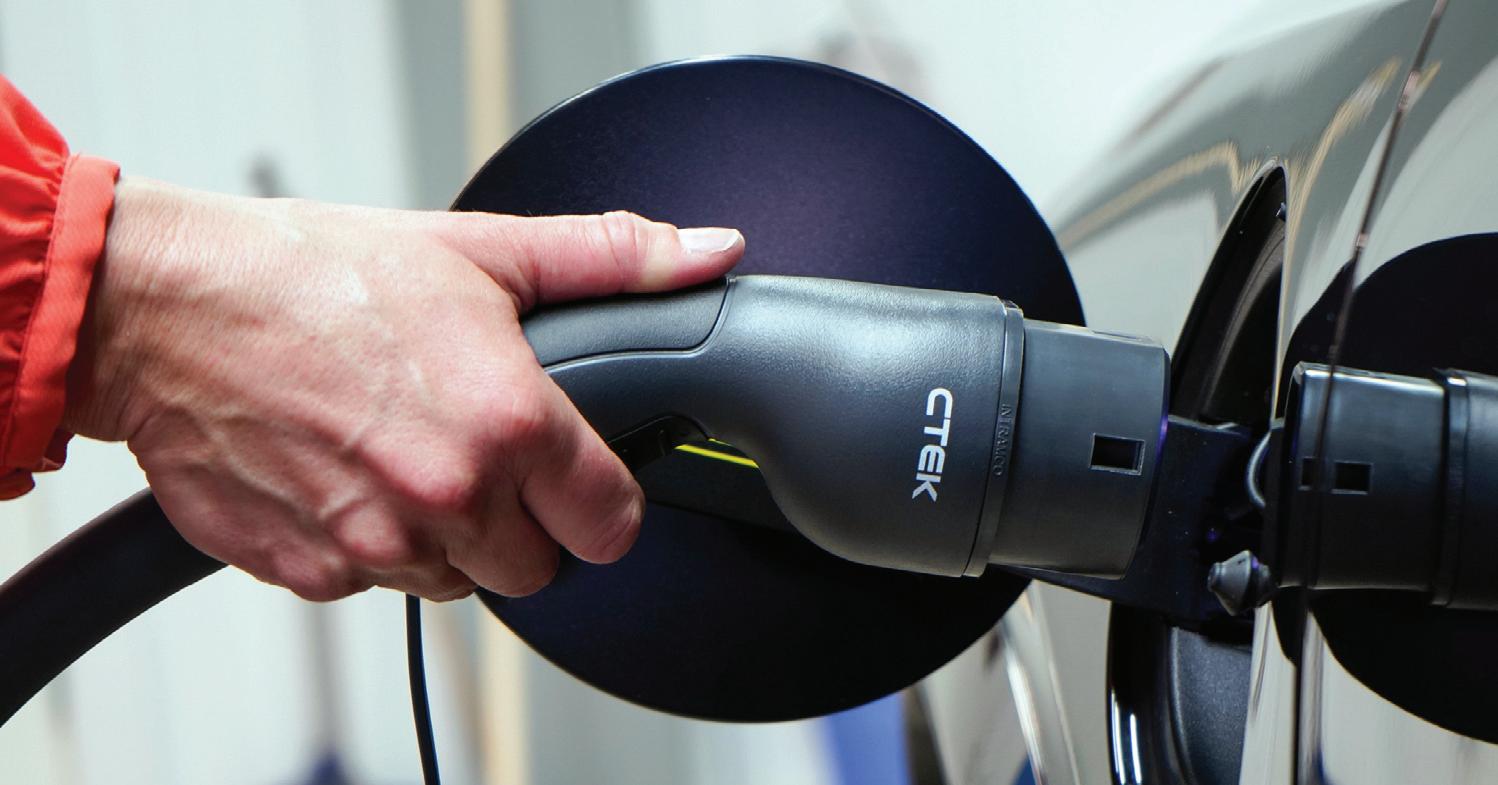
• Check that the charging equipment you are using has an OCPP 1.6 certificate from the Open Charge Alliance, the global consortium of public and private EV infrastructure leaders that have come together to promote open standards through the adoption of the OCPP.
• Consider if a Wi-Fi connection is the best solution for you. Many business customers today choose communication through an ethernet cable, rather than Wi-Fi. A Wi-Fi solution can work in many cases, but you must pay attention to IT security, so as to limit access for hackers. A physical ethernet cable is always more secure than a wireless connection.
• Company IT managers should be involved in the decision on how the charging system should be designed.
• Use a secure application programming interface (API).
• Turn off smart devices when not in use.
• Keep software regularly updated.

Vehicle manufacturers and chargepoint manufacturers, like CTEK, along with suppliers and app developers all need to take greater responsibility for cyber safety, and CTEK’s in-house software developers are working continuously to ensure that their back end systems maintain the very highest levels of security.
So far as the EV charging point itself is concerned, security is provided through the adoption of Open Charge Point Protocol (OCPP), which provides a standard for communication between different manufacturers’ charging stations and with back end systems. OCPP includes security protocols that are under constant development, and all CTEK’s chargepoints are fully OCPP compliant.
OCPP 2.0.1 has improvements in security, including the addition of secure firmware updates, secure logging and event notification and secure profiles for authentication (key management for client-side certificates) and secure communication (TLS).
However, some operators and service providers don’t want their charging data going through the chargepoint manufacturer’s network or cloud solution, partly for security and partly for privacy reasons and this may present some issues.
In newer versions of OCPP2, for example, there is a requirement that the charging station should also be identified, either by password or by a client certificate, and if the server for the chargepoint manufacturer’s cloud solution needs a password or certificate, the entire OCPP security set-up will fail. This suggests that operators and service providers who currently limit or prevent access to the chargepoint manufacturer’s network or cloud solution must find other solutions in the near future.
In larger charging networks, it has now become common to use Wi-Fi for communication between the charging stations themselves, and for communication with the load balancing system that controls and regulates the power supply going to the chargers. What’s important to consider then is that the Wi-Fi network can also then be an access point for hackers to the building’s computer network.
IT security is vital for the future of e-mobility, says Cecilia RoutledgeCTEK is taking greater responsibility for the cyber security of its systems
Stellantis has been running field tests of dynamic induction electric charging for electric vehicles (EVs) at the Arena of the Future in Italy. During months of testing at the Arena del Futuro circuit in Chiari, the global car manufacturer and its project partners demonstrated the capability of dynamic wireless power transfer (DWPT) technology to wirelessly recharge EVs as they travel over specially equipped, dedicated road lanes.
DWPT is a system of coils positioned under the asphalt that transfers energy directly to cars, trucks and buses without the need to stop at charging stations to refill the battery. The technology can be adapted for all vehicles equipped with a special “receiver” that transfers the energy incoming from the road infrastructure directly to the electric motor, extending the range, while conserving the vehicle battery charge.
The pilot project is coordinated by A35 Brebemi, a company owned by Aleatica, a global transportation infrastructure operator that focusses on sustainable and innovative mobility solutions.
“Our long-term strategic plan, Dare Forward 2030, is based on the premise of bringing ‘cutting-edge freedom of mobility’ to all and this project is the very essence of where we’re headed as a company,” said Anne-Lise Richard, head of global emobility business unit, Stellantis. “Working with this incredible group of partners, we have proven that inductive recharging technology can power our electrified future. These joint projects are exciting steps as we work to achieve longer battery lifespan, lower range anxiety, greater energy efficiency, smaller battery size, outstanding
performance and lower weight and cost.”
Work at Arena del Futuro shows that a battery electric vehicle, like the Fiat New 500 outfitted to test the system, can travel at typical highway speeds without consuming the energy stored in its battery. Tests are showing that the efficiency of the energy flow from the asphalt to the car is comparable to the typical efficiency of fast charging stations, so the driver does not need to stop to recharge. Furthermore, measurements on magnetic field intensity prove that there is no impact on the driver and passengers.
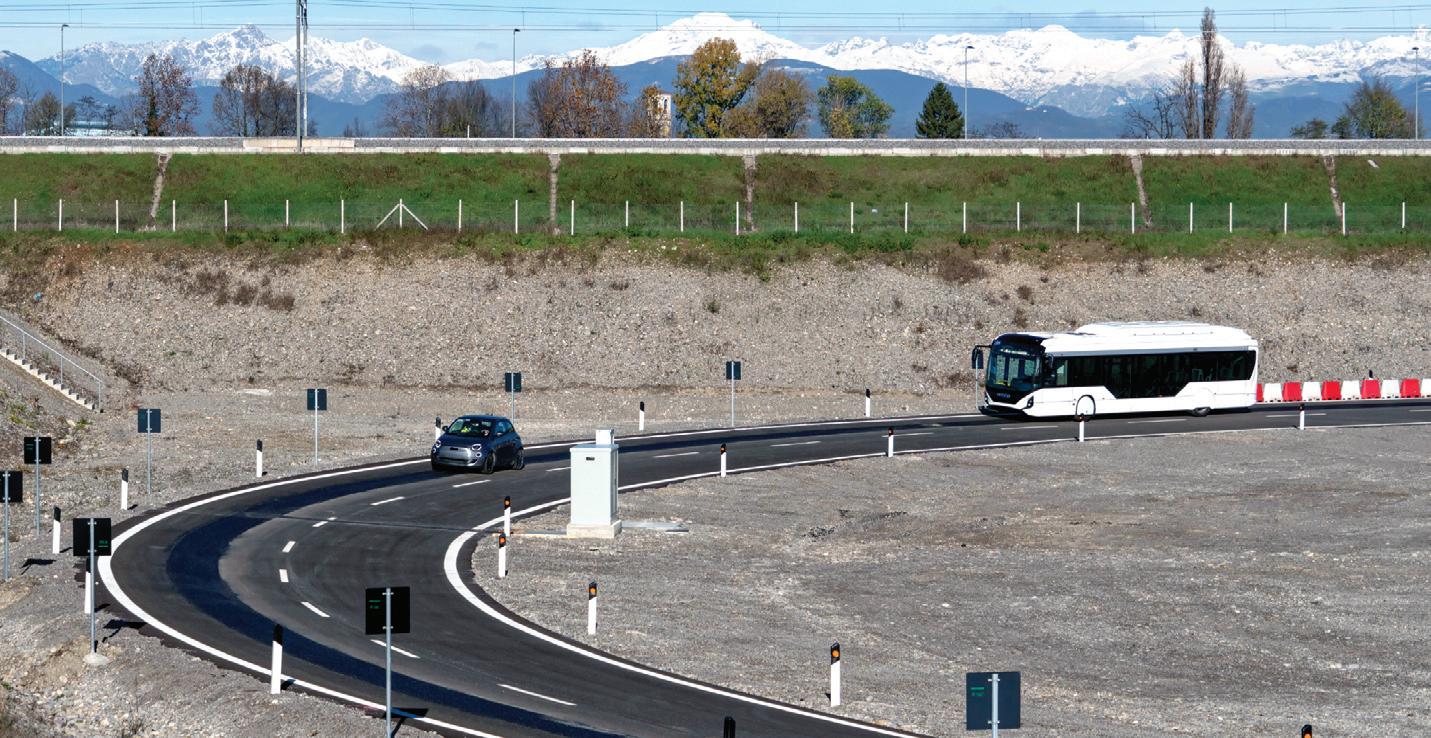
A flameless combustion system which allows green off-grid electric car charging has been created by an entrant in a competition funded by National Highways. The technology, developed by London-based climate technology company IPG, features a patented combustion process that produces the chemical reaction of combustion without the flame from any renewable fuel.
The company was one of 13 successful entrants in an innovation competition run by National Highways and Innovate UK. The competition encouraged technologists to come up with ideas to change the way roads are designed, managed and used with innovations that can be taken up across the transport sector.
Unlike traditional combustion technologies, IPG’s flameless combustion uses a hot air stream above the temperature at which any fuel, including green hydrogen, biofuels, or methane, will undergo spontaneous combustion. This creates an environment where reactions can be precisely controlled to reduce carbon emissions and prevent the formation of other

pollutants such as nitrous oxides and carbon monoxide.
Toby Gill, chief executive of IPG said: “Integrating modular and scalable renewable-fuelled power generation into our suite of solutions can help to bring electric vehicle charging to those locations where grid availability or stability is limiting electrification. This partnership with National Highways has been instrumental in defining where our technology will make the most impact and has been invaluable to get to the next stage of our innovation journey.”
National Highways hopes to ultimately eliminate carbon emissions from the strategic road
network. The government-owned company has set itself a target to cut carbon emissions through its own operations to net zero by 2030, while the target for road maintenance and construction will be hit by 2040 and all road users by 2050.
Annette Pass, head of innovation, said: “The competition may have come to an end now but the journey for the businesses that took part will continue a long time into the future.
“Decarbonisation is a key priority for the government and National Highways. We have charging points within 20 minutes of wherever you are on the motorway but they currently only cater for a small number of electric vehicles, and as those numbers increase it’s very important that we can cater for that.”
Karla Jakeman, connected travel lead at Innovate UK, said: “Innovate UK was delighted to be supporting National Highways and innovation in the transport sector through the Small Business Research Initiative (SBRI). This proven route to develop test and trial innovation offers vital funding to innovative organisations –helping them to develop solutions in partnership with the public sector.”
3ti, a designer, installer, funder and operator of solar car parks (SCPs), raised a £500,000 investment pot within an hour of opening its first crowdfunding round publicly.
The funding will accelerate the roll-out of 3ti’s pop-up mini solar car park and electric vehicle charging hub, Papilio3. The initial target on Crowdcube was exceeded within an hour, but the funding round will remain open for 28 days.
Launched in May 2022 at the Surrey Research Park, hosted by the University of Surrey, Guildford, Papilio3 can be deployed within 24 hours and provides up to 12 electric vehicle (EV) chargepoints. It integrates three technologies that are normally considered independently – solar electricity generation, battery energy storage systems and EV chargepoints.
“That we almost instantly achieving our initial investment target demonstrates a public belief in 3ti’s technology and our vision for renewable energy solutions,” said 3ti founder Tim Evans.

























Stand-up Kerry Godliman will be the special guest host of the British Parking Awards 2022

The British Parking Awards is a celebration of excellence and achievement by individuals, teams and organisations. The winners are revealed at a 4-star gala lunch that will be held in London on 16 September.
The line-up of celebrity hosts who have compered the event is one of the main reasons that over the past 20 years the event has become the highlight of the sector’s social calendar.
In the past we have been entertained by the likes of Shaparak Khorsandi, Dr Xand van Tulleken and Lucy Porter.
We are excited to announce that this year’s ceremony will be compered by the brilliant Kerry Godliman. Charmingly straight-talking and quick-witted, Kerry is one of the country’s best performers.
Kerry is best known for her TV appearances on Mock The Week, Live At The Apollo, Michael McIntyre’s Big Show, Taskmaster, Hypothetical, Ultimate Worrier and 8 Out Of 10 Cats
She is a regular on BBC Radio 4, where she has appeared on the esteemed News Quiz, The Now Show and Just A Minute, as well as her own series, Kerry’s List. She also starred in the hit series The Wilsons Save The World alongside Marcus Brigstocke, our 2021 awards host.
Kerry is an accomplished actress. Her roles include Derek, Call The Midwife and Mascots, as well as starring alongside Ricky Gervais in the hit Netflix series After Life, as well as playing the lead role in the detective series Whitstable Pearl
Proving the breadth of her acting range, Kerry also starred in the BBC military drama Our Girl and on stage in the National Theatre’s exploration of immigration, England People Very Nice
The 20th anniversary British Parking Awards take place at the Royal Lancaster London on 16 September 2022.
www.britishparkingawards.co.uk








Permits technology is a catalyst for urban transformation.
Imperial Civil Enforcement Solutions’ Ashley Bijster explains how
The last time I wrote an article, it was about the exciting developments around mobility hubs and their potential to transform our towns and cities. Now I would like to discuss a topic that may be perceived as rather more mundane, but which could have even greater transformative potential. I am talking about permits. To start, it is worth discussing permits as they are currently implemented. Parking permits are used all over the country and from a technology perspective they are the most complex aspect of our solution, and the area that presents the greatest challenges.
Permits are challenging because they follow no specific legislation, and there are countless ways in which they are implemented. Vast quantities of rules and permutations are applied from council to council – and the technology must accommodate them all through flexibility and configuration.
But the complexity of permits technology is what provides its power. Because these systems have been engineered for over 20 years to manage such complexity – and because the teams supporting them have developed deep knowledge of the tools and requirements – they can now be applied to tackle a range of related tasks.
Permits have already moved beyond the traditional requirement for on-street parking. Universities are a good example, where algorithms support the fair allocation of onsite parking spaces according to a range of factors, including distance/journey time, availability of public transport, requirements for school drop-offs en route and many more.
By liberating individuals from decision making, permits solutions enable universities to make consistent decisions without prejudice in line with their organisational objectives – which often relate to promoting sustainability and clean air.

Speaking of clean air, permits are also proving fundamental to the delivery of Clean Air Zones (CAZs). In Birmingham’s CAZ, which went live in June 2021, permits technology is used to manage exemptions for residents living within the zone; and also for visitors and patients of a children’s hospital and nearby medical centres – the first time that permits have been used in this way. Birmingham also uses permits to ensure the CAZ is fair to residents and visitors – a vital element, because winning ‘hearts and minds’ is a fundamental part of the process.
Similarly, Low Traffic Neighbourhood and School Streets projects involve extremely high volumes of exemptions for residents or their visitors – all of which can be managed with permits technology. The same is true of Blue Badge exemptions.
The emergence of online self-service portals has been fundamental here: enabling councils to manage expanding schemes without overwhelming administration work.
As the above examples illustrate – and factoring in the emergence of emissions-based permits which are now in place in some parts of the country – the requirement for permits solutions is only increasing. But there is also a trend towards such technology being applied in far broader ways than was originally the case.
This brings me to one of my favourite topics: the potential for authority staff with the ambition, vision and courage to apply existing technology in innovative new ways to solve their challenges.
Despite the impressive applications outlined in the previous section, I believe permits technology is not yet close to maximising its potential. Given that a permit is simply a prior agreement to undertake a particular activity, this technology could be applied to a far wider range of activities or undertakings. Indeed, permits are already being used by local councils in increasingly innovative ways: Thanet District Council in Kent uses permits technology to manage mooring spaces for boats, while another authority uses the same technology to manage truancy.
But ultimately, a permit can be used for almost anything that has a descriptor and a price. Allocation of skips or street trader locations are obvious requirements; but consider also lampposts and street furniture: permits could manage maintenance, providing access for tradespeople to carry out required repairs.
Other potential uses include taxi licensing, hospital vouchers and hotel parking – all of which could be managed and enforced through existing technology solutions.
But perhaps the most interesting development relates to management of utilities. I see great potential in the use of permits technology to manage utilities companies – for example, labourers requiring access to dig up roads or pavements to maintain gas or water pipes and so on. In this instance, the permits solution would enable council staff to manage access, monitor the duration of the permit, proactively check on works progress, and apply fines should the work overrun.
Use of technology not only removes a huge amount of manual work for staff; it also enables the council to retain tighter control over projects, ensuring payment is received for any overrunning, and even helping to keep projects on track. By linking the permits solution with external systems that manage processes requiring closures of roads or access, jobs could be scheduled simultaneously, thereby minimising works disruption upon citizens.
Tantalisingly, permits could also support the evolution and regeneration of our high streets. One notable example is by maximising the opportunity to make more street space available for local businesses – most obviously in terms of installation for extra seating for restaurants and cafes, though there may be many other potential uses.
This would extend some of positive trends which have developed over the past couple of years, including innovation around outdoor dining and greater appetite for supporting local businesses.
Permits technology would speed up applications and approvals processes, enabling more businesses to take advantage, and making it possible to respond quickly to developing situations or perhaps sporting and cultural events.

Demand for permits will only increase through the years to come. Our towns and cities are becoming busier, with more people, more movement and more modes of transport. Notably, the emerging ‘micromobility’ trend requires the management of scooters, ‘floating’ bikes – and whatever will come next. But, of course, what is not changing is the amount of space we have:
Ashley Bijster is managing director at Imperial Civil Enforcement Solutions. With over 20 years’ experience in outsourcing, enforcement and smart city technologies she is a widely respected figure within the industry. She was elected president of the British Parking Association in 2014 and is a regular speaker at industry conferences and seminars. With her knowledge of

councils are increasingly challenged to minimise congestion and effectively manage all available ‘kerb space’.
As I stated at the beginning of this article, permits technology is already extremely advanced and flexible – it has had to be because of the nature of existing parking permitting requirements. But if we wish to deliver the benefits outlined above then this technology must be harnessed more and must continue to develop.
Cloud-based self-service tools, such as those that already successfully manage on-street parking, are essential, because if we increase the number of permits, council staff must be able to manage the throughput.
Consideration of the ‘Customer Journey’ is paramount: interfaces must be simple to use and supportive for public users in order to maximise usage levels. Paper-free, self-service portals should be streamlined wherever possible, with elements such as third-party address verification look-ups (for example to Experian) automating data entry, making the process easier for the user and also the council.
Finally, do not forget the data, because permit applications represent an opportunity to capture precious information. The number of electric vehicles in an area can support town planning in relation to placement of future charging points; while car park permits will easily show how busy they are, which can inform pricing decisions that encourage the use of less popular locations.
Permits have been around for years. For some in the industry they have been seen as a monstrous challenge with headacheinducing complexity. But those of us who understand permits realise their potential and see them as one of the greatest tools we have as we aim to manage the movement of ever-increasing numbers of cars, and improve life in our towns and cities.
This
Parking permits been engineered for over 20 years to manage complexity and can be applied to tackle a range of tasks
Ashley Bijsterthe enforcement, environmental and traffic management sectors, she has helped to consolidate the company’s position as one of the most progressive, innovative and responsive operations in its field. Imperial Civil Enforcement Solutions is a UK-based provider of parking, environmental and traffic management systems with over 30 years’ experience in providing fully-integrated business processing and IT solutions to public authorities, universities, hospitals and private enforcement contractors. The Imperial team brings a combination of sector insight, technology skills and the experience of a number of successful service partnerships; providing the capacity, experience and expertise needed to deliver integrated enforcement solutions. www.imperial.co.uk article was produced in partnership with Imperial Civil Enforcement Solutions



Unity5’s Sharon Silcock says now is the time for permits to take centre stage
The digitalisation of a permit management system is not a new concept; however, the global COVID-19 pandemic has certainly accelerated the rate of digital transformation across all parking sectors. While initially the shift was to accommodate the “new normal”, organisations are quickly learning that this new normal has developed into an ongoing normal. To stay ahead, organisations must work with forward-thinking software suppliers that can successfully and securely facilitate digital transformation today whilst preventing any obstacles that may arise tomorrow.
Additionally, motorists’ attitudes towards online permit systems have changed over the last decade. The majority of people have at some point had a social media account or used Amazon to make a purchase, so the idea of purchasing and managing their own parking permit online is far more acceptable today than it was 10 years ago. Allowing motorists to have 24/7 self-serve access to their permit account prevents avoidable contact for our clients, reduces staff administration (saving clients both time and money), increases motorist compliance, and more importantly provides a better level of service.
North East Lincolnshire Council has worked with Unity5 to digitise its permits using ZatPark systems. Lynne Bromley, parking manager at North East Lincolnshire, says: “ Following the smooth

implementation of ZatPermit, staff spend far less time now in having to deal with calls and permit applications. Having the new software has enabled us to also easily introduce digital daily permits for staff, which has been well received. The back office management system has proved to be very flexible and easy for us to use so if we need to make a change to a permit type, we do not have to raise a support ticket. Also, the fact our permit system is fully integrated with our enforcement software makes our parking operations run far smoother.”
The transition towards virtual permits and virtual visitor vouchers (replacing physical permits and scratch cards) has greatly improved enforcement operations for all sectors but particularly for large permit operations like the one in place at Cornwall Council. Zoe Hall, community and civil parking manager at Cornwall Council, said: “Our civil enforcement officers are now able to check for digital permits through ZatMobile and whilst this is a mammoth task here in Cornwall with the choice of permits we offer, it has begun to reduce time checking for permits and therefore increasing patrol time and improve customer satisfaction.”
Unity5 has invested over half-a-million pounds in developing a future ready permit system, that is environmentally friendly with an unparalleled flexibility and autonomy. When considering this, a priority for the development team was that the self-serve motorist portal provided a positive user journey as well as being fully compliant with Web Content Accessibility Guidelines (WCAG) Level AAA accessibility standards. The portal can currently be used online on all web-enabled devices and is mobile friendly,
The transition towards virtual permits and virtual visitor vouchers has greatly improved enforcement operations
Sharon Silcock
however, the Unity5 developers are going a step further and creating a mobile permit app for 2022 to enhance the user experience, thereby taking it to another level.

Whilst developing the digital permit system, we consulted with our diverse range of clients and our partners in the industry to ensure we created a product that would enhance all parking operations across all sectors. As well as the motorist portal being a priority across all sectors so was the need for an easy to use yet highly configurable back office system that would allow organisations to be able to set up their own virtual permit types incorporating their own business rules.

Hannah Fuller, client services director of JustPark, says: “In my experience, permit specifications are amongst the most complex of parking configurations, as no two are the same and each local authority or operator has slightly differing requirements. As such, having fully configurable technology to manage permits has become less of a ‘nice to have’ but more of an essential requirement. Not only does this ensure that the customer can purchase and renew the correct permit quickly and easily, but it reduces fraud and the cost to the provider, and the data derived from the technology enables them to make smarter decisions.”
Unity5 has created a permit system with very easy to use backoffice screens that has received positive feedback from all users. With user training, clients can make all configuration changes themselves without having to contact the support desk.

Permit management solutions for healthcare and NHS trusts must focus on improving the parking experience for both patients, visitors, and staff. Hospital visits can be stressful, so it is important when an NHS Trust is considering a new system that they select one that is flexible and future ready so that it can adapt to the changing parking requirements of the staff, but also one that helps to alleviate the stress of parking for visitors, transforming the customer experience into a positive one.
There are many reasons why the digitisation of permit systems has become more relevant in a post-COVID world for local authorities, private parking operators, the NHS, universities, leisure, commercial and retail organisations but I would say the main reason is how the working lives of motorists have changed.
The pandemic increased home or hybrid working which has had an impact on urban centres and necessitated some new thinking about staff parking permits and how flexible they should be. Many of those staff who would commute daily to work previously may only need to be in the office for two or three days a week now, so their parking permits need to reflect that change.
There has also been change for universities based outside city centres, particularly where public transport infrastructure is inadequate or where more students have cars than they did when the university was built. These universities have seen increased demand for campus parking, and there is therefore a greater need for a formalised system to be put in place to manage the space available. The student audience is clearly one where using technology for this system is a given.
Local authorities work with their local communities, including residents and businesses, to provide fair access to both on-street and off-street parking. Creating traffic management policies that aim to reduce congestion and improve safety for pedestrians and drivers means that they introduce a wide variety of permits to meet their community needs. Pricing models may include higher charges for second and subsequent vehicles at a given property and there might be environmentally driven higher charges for vehicles emitting higher CO2 levels. It is important when choosing a software provider that local authorities consider a system that is already set up for emission-based permits and also one that gives them the flexibility to still print certain permit types in residential areas that are not quite ready to go fully digital.
Private parking operators seek to maximise revenue from their car park assets or ensure regular turnover of parked vehicles to maximise footfall in retail shops. They may have to manage waiting lists where demand is high and incorporate a points system to determine where individuals/organisations slot into waiting lists.
The new Parking Code of Practice, once fully decided, might also have an impact on permits for retail parking spaces where a range of options might need to be available for workers or for the public, such as daily permits allowing for parking at specific times on certain days, and this need for flexibility will require a highly configurable and autonomous permit system.
With so many different audiences and so many different requirements, it is clear that the only way to deliver the needs of the future is by harnessing the advanced technology that is already available, and using software developers, experienced in the parking sector, to create flexible and configurable permit systems.
Sharon Silcock is head of business development for Unity5 (ZatPark software) www.unity5.com
Parking permits have long been used to give parking rights to specific user groups.
Some of the most obvious groups include residents, Blue Badge holders, NHS staff and low-emission vehicles. Each cohort must meet specific criteria to qualify for a parking permit.
For many years, permits of all types used to be paper-based and often included the vehicle’s registration number. To prevent fraud, permits also featured a secure design element, especially in the case of visitor parking permits, where the car registration number would not be known in advance.
Administering paper-based parking permits, however, is a lengthy process, as many councils know. The London Borough of Ealing, for example, is a growing area that has welcomed over 30,000 new residents in the last 15 years. Such expansion led to a massive increase in the number of applications for visitor parking permits coming into the council.
People had two choices: they could either request paper scratch cards, for which a resident had to request a paper application form from the council, complete it and send it back. Processing these forms would typically take 14 days.
Alternatively, residents could book online, but first the council had to establish their residency. This assessment was done manually, and it was not the quick and easy solution the residents, or the council, were looking for.
From
Thanks to the rise in adoption of cashless parking, it has become much easier for councils to provide and to manage parking permits, doing away with the inefficient scratch cards.
Ealing Council was already using PayByPhone as its cashless parking payment provider, and we worked on a bespoke solution to offer resident and business visitor permits within the by now already-familiar app.

The new system cleverly harnesses the power of ‘Big Data’. A resident requesting a visitor permit enters their details, which are checked against a multi-layered, highly-secure and confidential verification system.
Using postcode mapping software and verification services, residency is determined in a matter of seconds. If approval is not granted via the app because they have just moved to the area,
for example, then the resident can securely upload proof of residency for the council to review. Documents are deleted after the assessment has been completed, so even where there is a level of manual intervention, nothing needs to be posted or emailed, making the process as quick and secure as possible.
Residents who are eligible but are unable to use computer or smartphone technology can complete the process by phone.
Digital parking permits deliver a better parking service to Ealing residents and businesses.
The smart interface makes the process of purchasing permits much easier. Ealing Council saw a significant increase in resident accessibility, and usage of, visitor parking permits.
It is much faster too: in the first six months after the roll-out, 78% of applications were verified and automatically approved. Residents no longer have to wait weeks and there is no need to keep returning to the vehicle to place a scratch card on the dashboard.
Ninety-eight percent of visitor parking permits generated by Ealing Council are
sold electronically and the entire process takes a matter of minutes, saving the council’s parking team precious time and resources – an estimated 85 working days a year.

The solution has since been applied to wider public sector organisations. It is possible, for example, to charge differentiated rates for motorists who meet certain criteria, such as Blue Badge holders, key workers, GPs and carer staff –all of whom need to park across a wide range of locations across a borough to go about their daily lives, or to perform their jobs.
Resident visitor permits schemes demonstrate how local authorities and car park operators can harness technology to better serve residents, business communities and users by creating a more streamlined and cost-effective approach to parking services provision.
Cashless parking makes it much easier for councils to provide and to manage parking permits Rebecca Maisey
Cashless parking has transformed how councils and car park operators manage permits, says Rebecca Maisey
Digital permits can be managed on smartphone
Facebook’s transformation into Meta in November 2021 was a signal that the technology giant is seeking to work across all areas of the virtual world, a domain it refers to as the “metaverse”. But the work of running the metaverse requires 60,000 people to work in the real world.

Meta Platforms has signed a deal with New Zealand staff parking optimisation start-up Parkable to help it solve parking woes faced by employees across all its physical offices. The announcement was made in during NZ prime minister Jacinda Ardern’s June trade delegation to the US which focussed on hightech exports.
Toby Littin, co-founder and chief executive of Parkable, says: “Never before has the office parking conundrum been so difficult; sparked by employees globally returning to offices in a very different manner to pre-COVID ways of working.” Companies are facing very real challenges in ensuring their office parking is as flexible as their hybrid working policies. Too often, parking sits empty, and can’t be easily shared between those coming into the office.
Parkable solves the challenge by providing an efficient system for fairly managing and allocating parking for a newly flexible
workforce. The system seeks to let employees plan a seamless commute by booking their parking in advance, should they choose to come to the office.
Parkable believes its solution pays dividends in employee happiness. “One of the most valuable lessons from the pandemic has been that employee experience is key to attracting and retaining talent,” says Littin.
“For many, the work day starts long before their first meeting. A modern approach to optimising this experience includes improving employee commute and parking options. We
applaud Meta for taking a forward thinking approach to looking after its people.”
The sustainability benefits inherent are significant, Littin adds. “The old model of one parking space for every employee is solved using tech to better manage allocations and the more efficient sharing of space. Parkable enables parking spots to be pre-booked, reducing congestion created by circling for a park. It also lets people know not to drive to work when there are no spaces available, and to use alternative transport – encouraging active and public transport use,” says Littin.
Parkable is helping Meta solve its real world staff parking woes
Meta’s vision of how we will engage in the future
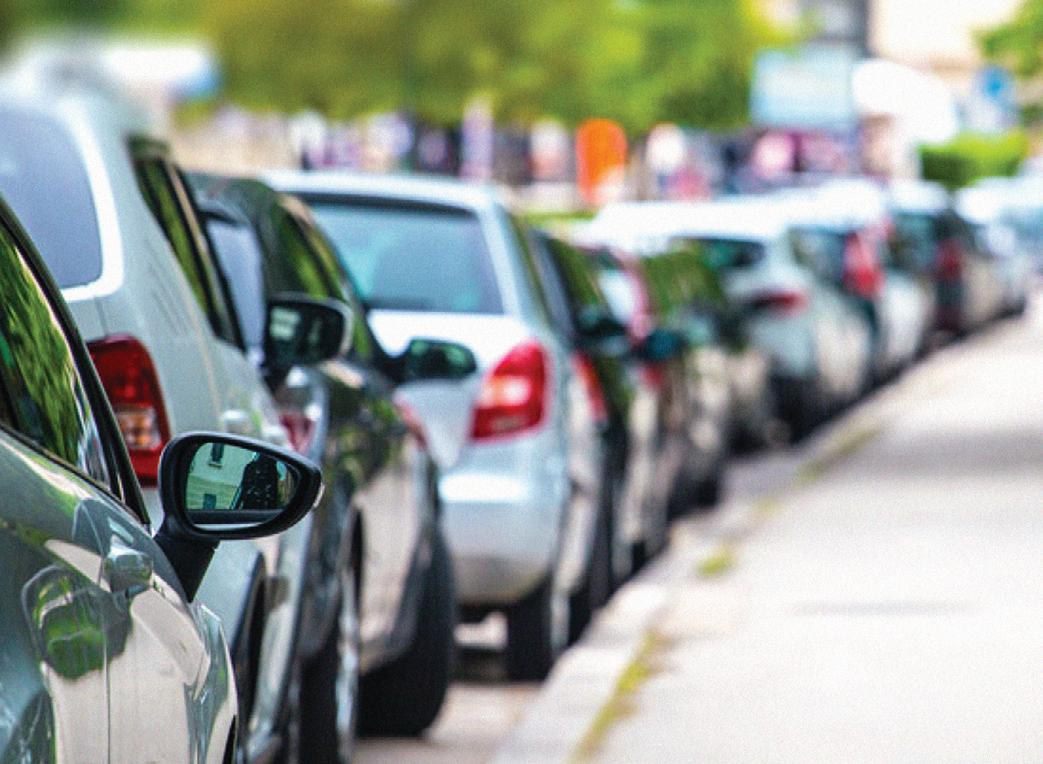
with paper permits posted to successful applicants for display in vehicles. This process was highly labour intensive, requiring many back-office staff. The transition to virtual permits has reduced the effort, but as the next section will show, the challenges associated with managing complexity have arguably exceeded those related to workload.
There is no doubt about it: managing permits is hard. I have been involved with their implementation since the early 2000s. While they were complex then, they are even more so today. Early permits implementations, which first arose in the London boroughs, required residents to send paper applications together with required evidence to the council. Contents were scanned and processed,
We probably all know of organisations that have made the mistake of thinking permit systems used in other sectors can be easily transferred into local authority environments. In my opinion their error was in failing to appreciate the vast complexity involved. But what exactly is it that is so difficult?


Firstly, all councils do permits differently, and they all tend to have rules. Many, many rules!
Consider a ‘standard’ parking permit for residents. Historically, councils have tended to have upwards of 20 different permit types – in some that might be as many as 50, to cater for the various elements that make up the eligibility and pricing of the permit. The above scenario applies to the most basic resident permits – and the complexity increases significantly with those that apply to businesses, specific street locations and so on.
Additionally, there is a trend towards highly complex Controlled Parking Zones (CPZs), including restrictions applied to parts of streets, or bays outside particular house numbers; or one side of the road but not the other. Of course, this makes things difficult for civil enforcement officers as well as system suppliers. Now consider that the above rules, many of which may involve scaling pricing, vary from region to region. We all know parking regulations can be confusing for members of the public – so just imagine coding the rules to accommodate the almost countless scenarios.
Barry Johnson from Taranto Systems on the history of permits and how technology is taming their complexity
All councils do permits differently, and they all tend to have rules. Many, many rules!
Barry Johnson
From a technology perspective, managing permits has always been a challenge. Over the years we have found that when working with a new client, even with a highly developed system, we typically cover around 95% of an authority’s requirements ‘out of the box’ – leaving 5% requiring additional development.
While permits have always demanded flexibility of technology suppliers, the requirements continue to increase, driven by a range of factors including permit waiting lists; the need to accommodate growing numbers of residents in flats and apartments; and scaling pricing for multiple permit households, vehicle types, and parking locations.
Emissions-based permits are another area of growth. Already used in boroughs such as Ealing in west London, I expect this trend to continue as councils aim to encourage a shift to electric vehicles. It is also worth noting that we are seeing increasing demand for permits in private parking, though the requirements tend to be far less complex, so solutions developed for the public sector are well equipped to manage this area.
But perhaps the most significant recent change is the shift towards the public managing their own permits via online portals. Residents can set up their own accounts, log in, and view or apply for a range of applicable permits, with those not relevant hidden from view.
Self-service minimises fraud by restricting applications based on relevant eligibility criteria such as location, reduces workload for back-office staff, and enables residents to access their account at any time and from any location.
Councils rightly take permits very seriously – they are vital to manage correctly and can be highly frustrating for the public. As I have tried to show in this article, permits are incredibly complex. Suppliers must provide highly developed technology integrated with third-party systems, delivered and supported by technology experts that genuinely understand the enforcement sector.

In the last five years Taranto has allocated more development resource to permits than any other area, resulting in a solution that can manage the complexity and scale required of modern permits solutions. However, permits will only become more ubiquitous and more complex. Applying the requirements outlined above will ensure we continue to deliver solutions that councils and the public require.
Barry Johnson is senior technical director at Taranto Systems, where he leads a team of more than 25 software developers focussed on delivering innovative technology solutions that support the enforcement and management of parking and traffic violations, parking permits and more. Barry has been central to the delivery of many of the UK’s most noteworthy enforcement implementations including London’s LEZ/ULEZ and congestion zones, the Dartford Crossing, and parking systems for more than 50 UK councils.
tarantosystems.com

To deliver permits technology in line with modern requirements requires addressing four key areas, each of which are summarised below.
Technology solutions must be highly flexible to manage permits’ inherent complexity. While much can be achieved through system development, we have also created extensive configuration to enable ‘superusers’ to add or edit permits without the need for chargeable services. This ensures responsiveness as changes are instantly reflected in the live system.
Another important element is the ability for users to easily create visual maps that clearly outline controlled areas and any exceptions. This gives council staff the flexibility to implement complex rules and share them in an easily understandable way –reducing workload and confusion for all concerned.
Some of Taranto’s largest local authority customers use permits, including Tower Hamlets, Wandsworth and Haringey. To provide an indication of the scale, almost 2 million permits are issued each year through the Taranto system.
Given increasing urbanisation, demand for permits technology will only increase. Consider the workload for council staff managing 500,000 permits per year – it’s just not possible without technology that can manage both the scale and complexity.
By integrating permits systems with local MyAccount; electoral roll and Council Tax systems; and external vehicle system checking systems such as Experian; the entire application and approval process is streamlined for all stakeholders.
Authority staff can review reliable information relating to proof of residence and vehicle emissions, reducing the workload required to process applications, avoiding fraud or underpayment, and ensuring that parking spaces are allocated fairly and paid for correctly.
Additionally, integration with ticket issuance software improves processes for civil enforcement officers, who can quickly and easily review permit information after entering or scanning a Vehicle Registration Mark on a handheld device.
We know permits can be frustrating for the public, so if we are asking people to undertake the administration effort, we owe it to them to streamline the process.
At Taranto we have spent a great deal of time thinking about user experience and have chosen to align our self-service portals with the .GOV webpage structure. This ensures they meet all accessibility requirements including readability, availability of voice control, adoption of Responsive Web Design (so the site works well on different device types) and more.
Additionally, aligning with the .GOV structure ensures a userfriendly interface with a familiar look and feel, and consistent workflows to guide users through processes.
As a result, applications are as simple as possible: integration with council tax and electoral role systems automates data entry and minimises required evidence; where evidence is needed the instructions are clear and documents can be instantly uploaded; and where permits are specific to a vehicle this can be automatically completed based on vehicle registration information.
This article was produced in partnership with Taranto Systems
Finally, it is also possible to automate the approvals process, so successful applicants receive permits without delay.

The digitisation of traffic and parking management was a recurring theme in presentations by the Department for Transport (DfT) at Parkex 2022. Transport minister Baroness Vere of Norbiton extolled the benefits of digital parking in her keynote address in the Parkex Hub. She discussed a range of schemes that aim to make it easier for drivers to pay for parking, including the National Parking Programme and Alliance of Parking Data Standards, both of which are supported by the British Parking Association (BPA).

The DfT’s National Parking Platform programme promotes the idea of using open data to provide drivers with a frictionless parking experience. There will also be benefits for parking operators, said the Baroness. “The platform will make a difference to local authorities and save them money on the procurement process due to standardisation, economies of scale, avoiding supplier lock-in, and time,” she explained.
The DfT’s ITS policy lead Darren Capes addressed the issue of digitisation in more detail during the Local Authority Summit strand. He discussed progress being made on the National Parking Platform pilot project in Manchester, the digital Traffic Regulation Order (TRO) discovery project and the expansion of moving traffic enforcement across England under Part 6 of the Traffic Management Act.
“Two words summarise government policy right now: carbon
neutral,” said Capes. “We are looking at how we put data and standards together to see where the government needs to intervene to support local authorities, and where things are better left to councils and associations like the BPA.”
Capes explained how the TRO discovery project feeds into both enforcement powers and the wider network duty management of local authorities. He posed a question: “What do we need to do to make sure people, no matter what form of transport they use, have equal access to the kerbside?”
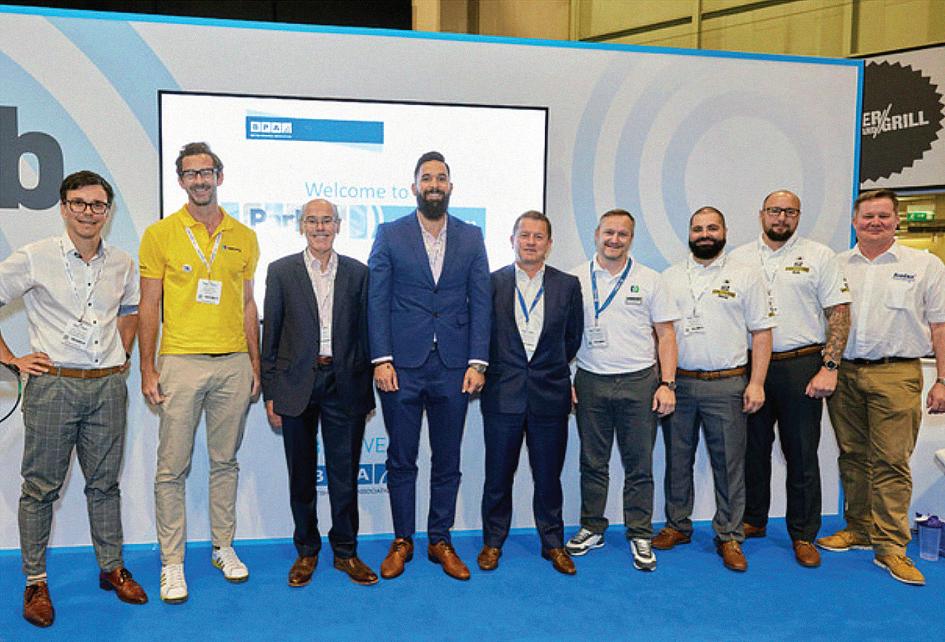
The wider policy perspective was picked up by Anthony Ferguson, the DfT’s deputy director, transport and technology, in a discussion on the future of parking. He set out how digital and data initiatives such as the National Parking Platform and the TRO discovery project can play a role in optimising use of the kerbside and street “Parking is one strand of a more complicated picture,” he said. “We want it to do increasingly complicated things with the same infrastructure, but the space between the buildings is not changing, it is analogue.”
However, Ferguson struck a note of caution, pointing out that when looking at how streets work, there are other factors to consider beyond efficient parking. “We just need to be aware that if we make it easier for people to access on-street and off-street parking, then will people do more of it? We could end up with more vehicles,” he warned. “Street space is highly contested, as we have seen with the introduction of Low Traffic Neighbourhoods. Making sure the technology delivers the right policy outcomes is the real challenge.”
Two
The Department for Transport sets out its plans for data-led street management at Parkex 2022








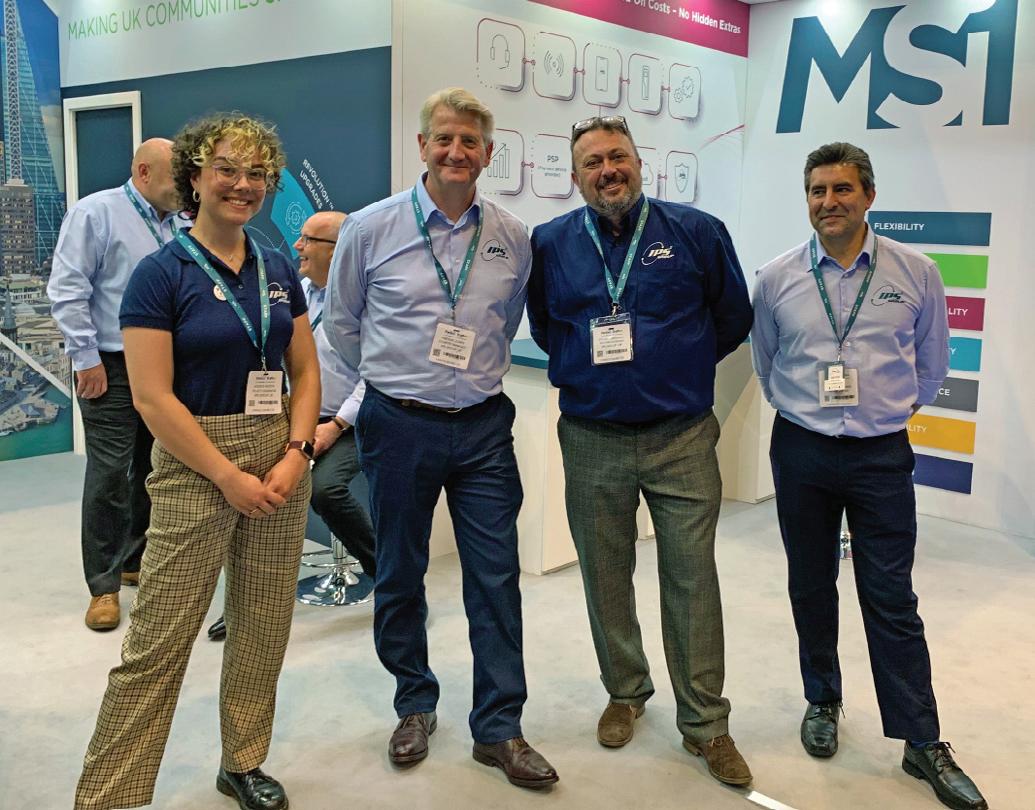

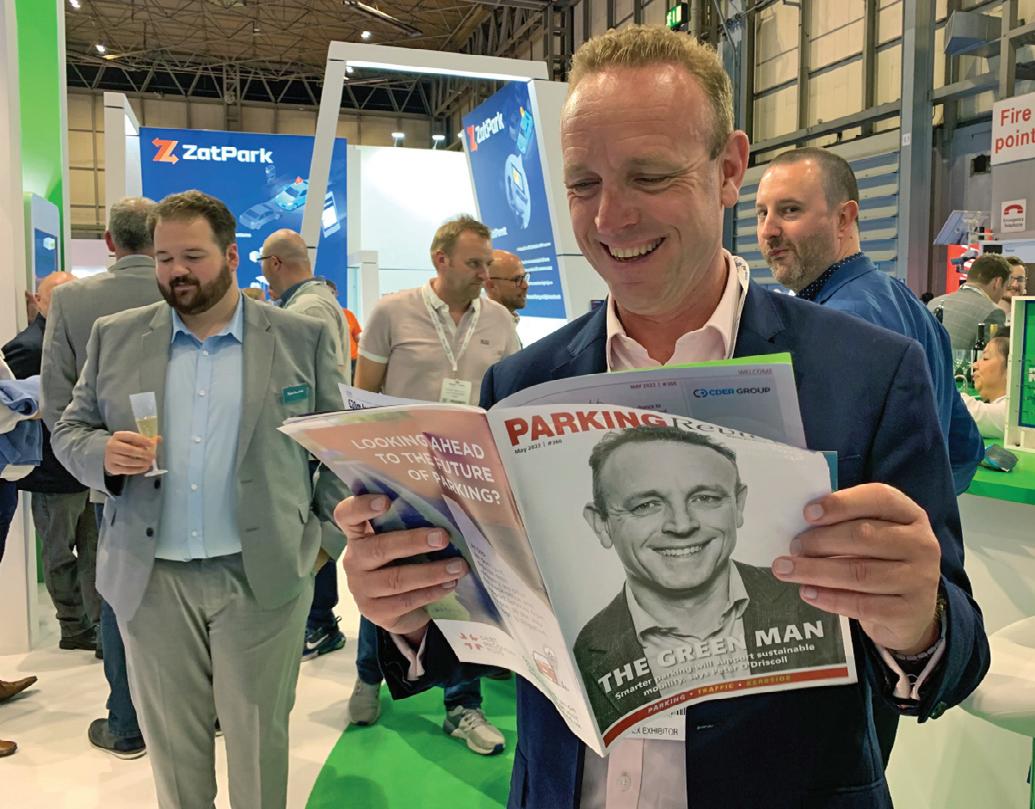

The Etruscan Square master plan will see the creation of a new arena, housing, shopping and car parking in the city of Stoke-on-Trent. The new 701space multi-storey car park will be built on the site of the old Meigh Street car park, which is currently being demolished.

By accommodating vehicles off-street, the car park will facilitate the extensive pedestrian public realm within the wider masterplan through its provision of sustainable travel options.
The wider Etruscan Square development was backed last year by a £20m investment from the government’s Levelling Up Fund. It will feature a 3,600 capacity arena, 285 high quality residential units, commercial space and a 138-bed hotel.
Cllr Daniel Jellyman, cabinet member for infrastructure, regeneration and heritage, said: “To have a large development space like this available in the city centre, in such a prominent location and in our ownership, doesn’t happen very often. This is a real once in a generation opportunity to create something unique and lasting for Stoke-
on-Trent, that would offer social and economic impact and benefit on an unprecedented scale for the next 20 to 30 years. It will be catalytic in reinvigorating and bringing viability back to the city centre as well as attracting new businesses.
“We were successful with three bids to the government’s Levelling Up Fund for a total of £56m, and the funding bid for Etruscan Square was absolutely vital to getting this scheme off the ground. We are looking at a phased delivery here over the next 10 years.”
Potter Church & Holmes Architects (PCH-a) have designed the car park to operate
as a mobility hub. It will include electric vehicle charging spaces, disabled parking bays, a customer and an active travel and Shopmobility centre.
PCH-a director Mark Potter said: “There is currently an overriding need to provide a modern car park facility in the area to support the viability and vitality of the city centre along with the retail area to the West and North.
“The Etruscan Square masterplan will generate a parking need, which this building will serve. In the longer term, it will serve the arena proposed in the masterplan and will be a general catalyst for regeneration.”
The name Etruscan Square

A £15m car park is due to open in Stoke this summer. The 730-space car park is being built for Stoke-on-Trent City Council off Potteries Way in Hanley. The project is being managed by Genr8 Developments, which is overseeing the creation of a 140bed Hilton Garden Inn hotel, 151 flats and three office blocks on the neighbouring Smithfield site.
The Smithfield multi-storey forms part major changes to off-street parking provision in the city. The car park is being commissioned as the city council is currently demolishing the Meigh Street multi-storey in Hanley to make way for a new car park within the Etruscan Square development.
Development manager Joel Chandler said: “It has been amazing to see how Smithfield has grown over the past seven years, and the new multi-storey is yet another important part of the Smithfield masterplan that will not only help Smithfield residents and tenants, but also the wider town centre. It was vital to us that we were able to support the gradual shift towards sustainable, electric cars too, which is why we have included vehicle
charging points in the car park and future proofed the design to ensure we can fit out additional spaces with new electrical charging points taking emerging technologies into consideration.”
There will be a two-lane entrance for cars off Cannon Place, with motorbikes and bicycles using Cambridge Street.
Council deputy leader Daniel Jellyman defended the investment in the new car park. “Like all our council-owned parking places, all surpluses fund front-line highway and environmental services, so this car park is going to keep generating much-needed income for the city that will benefit residents and taxpayers for years to come,” he said. “Improving the quality and
is a nod to Stoke-on-Trent’s past: Etruria was an ancient region in Central Italy, located in an area that covered part of what are now Tuscany, Lazio and Umbria. The ancient people of Etruria are identified as Etruscans and were admired in the 18th century.
Josiah Wedgwood was inspired by ancient pottery then generally described as Etruscan. In 1769, Wedgwood opened the Etruria Works ceramic factory, named after the Etruria district of Italy, where black porcelain was being excavated.
Wedgwood found this porcelain inspiring, and his first major commercial success was its duplication with what he called “Black Basalt”. The factory ran for 180 years. Wedgwood’s home, Etruria Hall, was built between 1768-1771 near the factory.
“Announcing the name is another significant milestone in this exciting project. We wanted a name that celebrates our past but also inspires hope and confidence for the future, and linking it to one of Stoke-on-Trent’s most famous sons certainly does that. We want Etruscan Square to be a brand that people will instantly recognise and remember, and become a new chapter for the city,” said Cllr Jellyman.
availability of parking for residents, businesses and visitors in the city centre is something that has needed addressing for some time and this is another massive step in the regeneration and development of the area. Investments like this multi-storey car park, making sure we have first class infrastructure as the city centre continues to grow and improve, is absolutely vital to supporting the local economy and our ambitions. With hundreds of people working across One and Two Smithfield, the Clayworks apartment block that is fully let and the Hilton Garden Inn hotel up and running, the Smithfield development has been a major success, and this continues the story of growth.
“This state-of-the-art car park is being built with the ability to fit out new electrical charging and emerging technologies, that will support not just what is on offer now but the next 50 years and more. And with £20m secured in Levelling Up funding from the Government to develop the nearby Etruscan Square, which will include a purpose-built arena and event space for the city centre and other fantastic facilities, there’s plenty of development happening in the area where people will need parking.”

Property investor and car parking operator Town Centre Securities (TCS) has entered a joint venture with Glenbrook to develop the Whitehall Riverside scheme in Leeds city centre.

The masterplan proposes a riverside mixed-use scheme three minutes walk from Leeds railway station. It will be created on what is currently a surface car park owned by TCS, which recognised the opportunity to develop a new neighbourhood in the West End of Leeds.
The masterplan by Enjoy Design brought forward by TCS envisages a development comprising space across two buildings and a 108-key aparthotel.
There will also be a 478-space CitiPark multi-storey car park and travel hub that will deliver what would be one the largest EV charging sites in the north of the UK using renewable and sustainable electricity.
The proposals include extensive residents’ amenities split across the ground floor and mez-
zanine with terrace garden overlooking the River Aire.
The landscaping and public realm envisages a new riverside park that will enhance the biodiversity of the riverside environment. A series of interlinked green streets and cycling routes will improve connectivity and access to the existing riverside to create a high quality destination, attracting new residents and visitors to the scheme.
Craig Burrow, development director at Town Centre Securities, said: “We are excited to be bringing the new Whitehall

Riverside masterplan forward and are confident the proposed mixed-use approach will unlock the full potential of this incredible site. “The proposals are the culmination of a collaborative partnership and it’s a pleasure to work towards a shared vision and goals with Glenbrook for the transformation and activation of this significant stretch of riverside frontage.”
Danny Roberts at Glenbrook added: “Having developed a number of build to rent schemes across the UK in recent years, we have been looking to expand
our presence into the Yorkshire market. Located close to Leeds’s premier commercial district, this development site was an attractive proposition, only increased by the prospect of working with TCS and we look forward to working with them to deliver the masterplan vision.”
TCS has worked with Leeds City Council over the years to bring forward the initial phases of No.1 Whitehall Riverside (offices), Whitehall Waterfront (residential) and most recently the Premier Inn (hotel) which was completed in 2017.

Salisbury
The Agony in the Car Park, Grayson Perry’s striking tapestry featuring a suited man being crucified, is being shown at Salisbury Cathedral. It is one of six tapestries, each 4 metres by 2 metres, that make up his 2012 collection The Vanity of Small Differences.

Over the last decade the tapestries have been displayed in galleries, museums and stately
homes, but this is the first time the works have been displayed in an religious setting.
Perry said: “It was conceived as a public artwork and I wanted to see the tapestries shared with very wide and varied audiences. My hope remains that it not only delights the eye and engages visitors, but sparks debate about class, taste and British society.”
The Very Rev Nicholas Papadopulos, dean of Salisbury, said the cathedral is a perfect setting for Perry’s parables.
“Perry’s titles and a lot of his forms are drawn from medieval
sacred art,” he said. “The originals were inspired by buildings like the cathedral and the stories told here. What we are doing is completing the circle. We’re returning these tapestries to the building that inspired the paintings that inspired Perry. I think they belong here, in a sense.”
The Adoration of the Cage Fighters references paintings such as Andrea Mantegna’s The Adoration of the Shepherds, while The Agony in the Car Park plays on Giovanni Bellini’s The Agony in the Garden.
The subject matter of the
tapestries was more relevant than ever, Papadopulos told The Guardian. “Perry is interested in social cohesion and social division. In the time since these tapestries were created, we’ve had Brexit, COVID, war in Ukraine, the cost of living crisis. What I think the tapestries do is give us a perspective of how we are seen; Perry’s view of what our society looks like. It’s entirely valid and proper that they are shown here.”
The Vanity of Small Differences will be on display from 29 June until 25 September 2022
House hunters were confused by an advert featuring a property with a garage but no driveway. Developer Anwyl Homes advertised a home with grass in front of the garage on Facebook. Instead of a drive leading up to the garage there was an area of neatly trimmed grass, while directly in front of the garage door is an array of potted plants.
This prompted one social media user to ask: “I’m intrigued. How do you get a car in the garage?”
The developer responded to confirm that the detached property was just a show home at its 66 home Mill Green estate near Lytham in Lancashire. “Landscaping in front of the garage is for show home purposes only,” said the company. “We wouldn’t want to obstruct your view of our lovely houses with vehicles.”
Mathew Anwyl, housing managing director for Anwyl Homes, told MailOnline: “We appreciate the photo may have caused people to do a double take, but it’s usual practice at new developments to create a safe walking route from our sales office to our show homes.

Supported by:
Traffic and parking management teams provide an essential service. They keep our towns and cities moving. They work to provide sufficient, equitable and safe access to the kerbside for residents, shoppers, businesses, people with disabilities and the emergency services.
Traffic + Parking 2022 will examine themes such as themes such as:
l Civil parking enforcement l Moving traffic regulation l Clean air schemes l Parking payment services l Kerbside management l Signs, lines and TROs l Low Traffic Neighbourhoods l School streets l Electric vehicle charging l Mobility hubs l Pavement parking l Residential and permit parking l Public consultation l Blue Badges
l Cycle, e-bike and e-scooter parking l Road user charges
The conference will feature expert presentations and topical debates.
If you have an idea for a talk contact the event’s programmer Mark Moran, Editor, Parking Review E: mark.moran@landor.co.uk


Presented by:
Organised by:
Local Authority / Third Sector Free


Private Sector £225 + VAT

Traffic + Parking 2022 provides your company with the perfect opportunity to carefully target the marketing of your products and services to those within the smart city planning, active travel, intelligent mobility and parking sectors. To participate in this sector-defining event contact Jason Conboy


T: 020 7091 7895
E: jason@landor.co.uk

Exhibitors include:
Local authorities and their partners are focussed on reducing traffic congestion, ensuring the free movement of public transport and safety of pedestrians. They are increasingly key to enabling active travel, as well as implementing schemes that reduce vehicle-related pollution and delivering electric vehicle charging infrastructure. www.traffic-parking.uk





























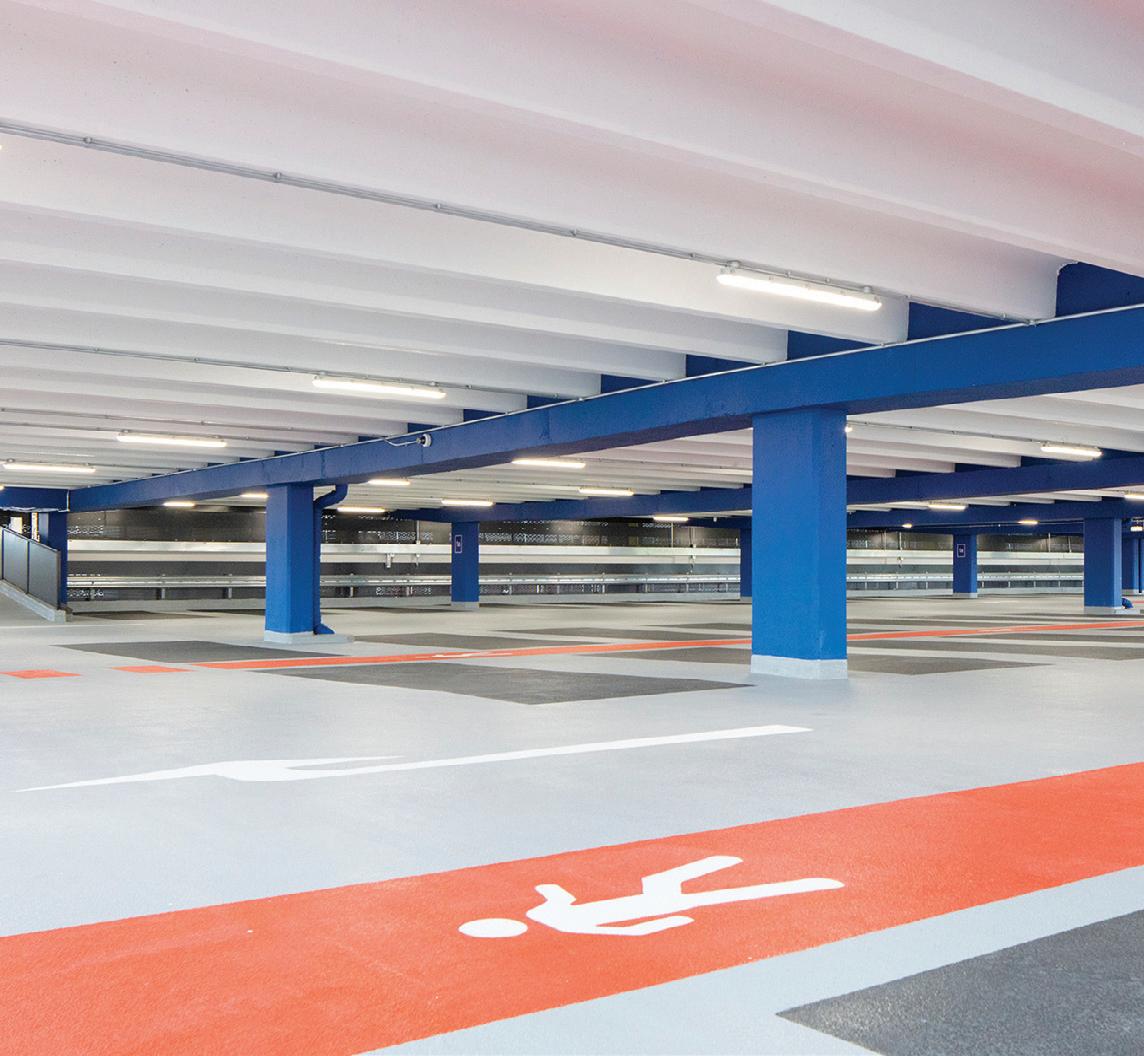








We can help to increase your parking recovery payment rate, identifying new opportunities where others have failed.
With support from our sister companies in the Bristow & Sutor Group, we can offer a complete litigation and enforcement solution.
For more information, please contact sales@drpl.co.uk or call 0161 214 8058